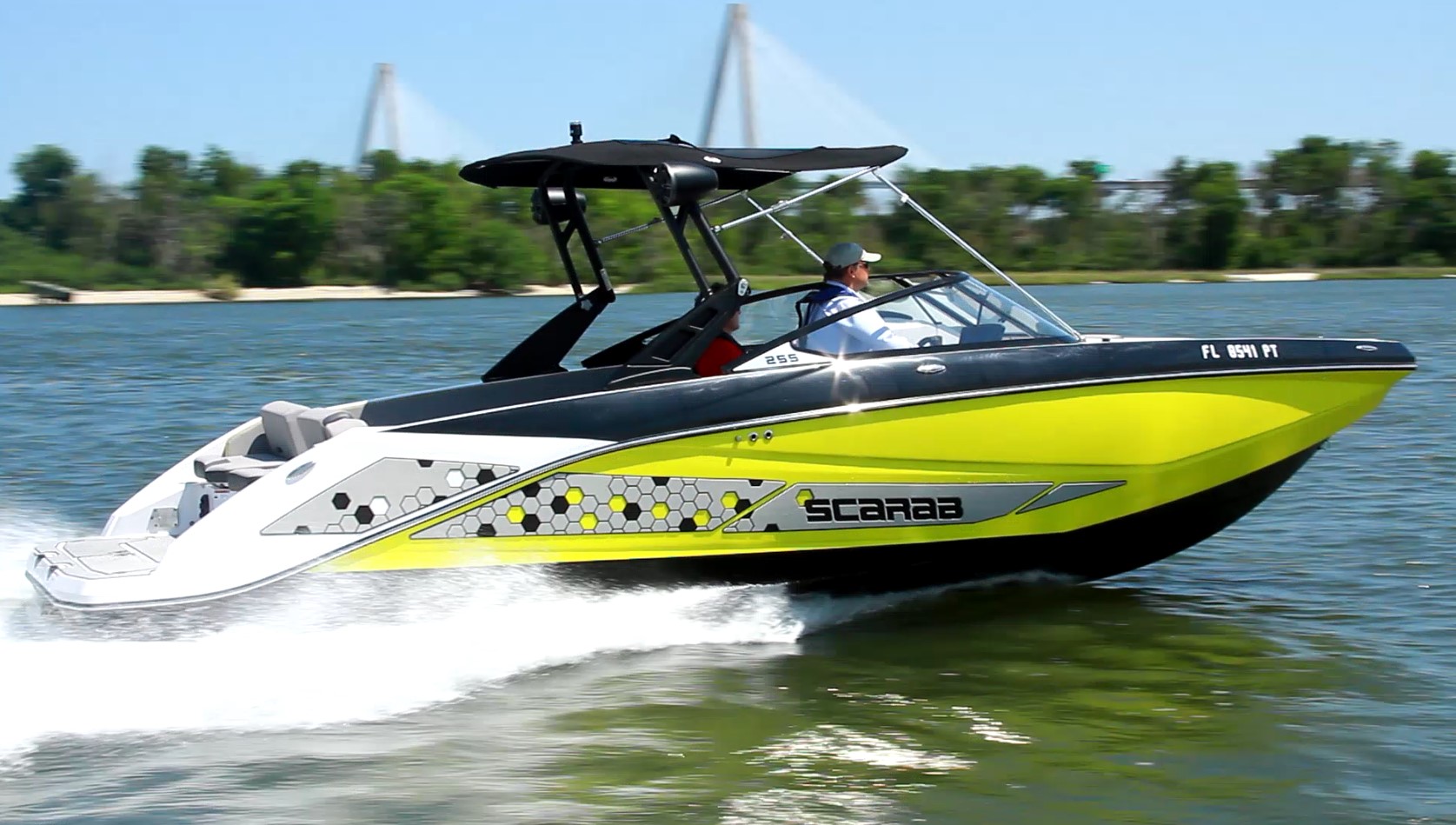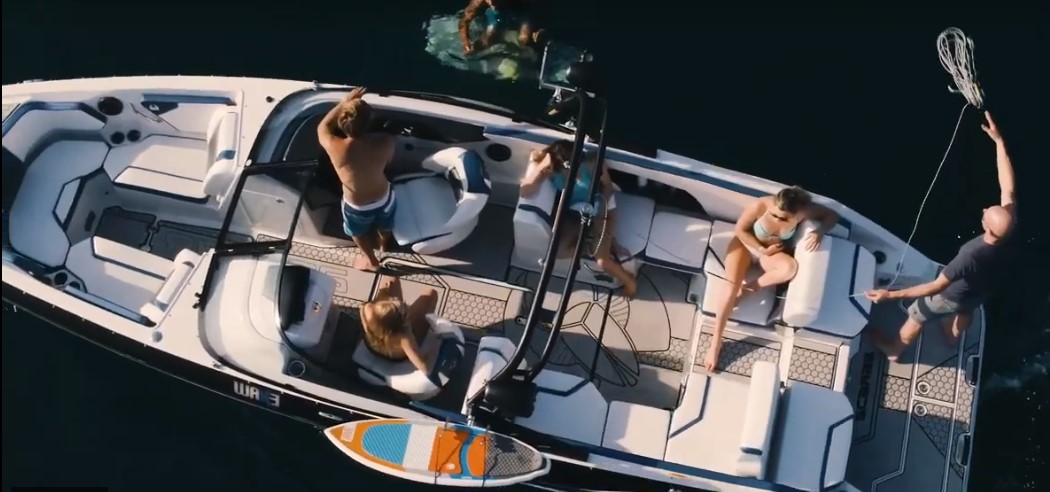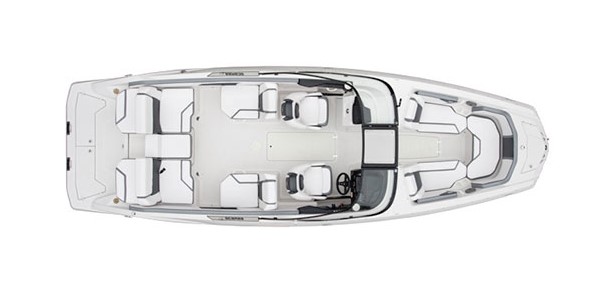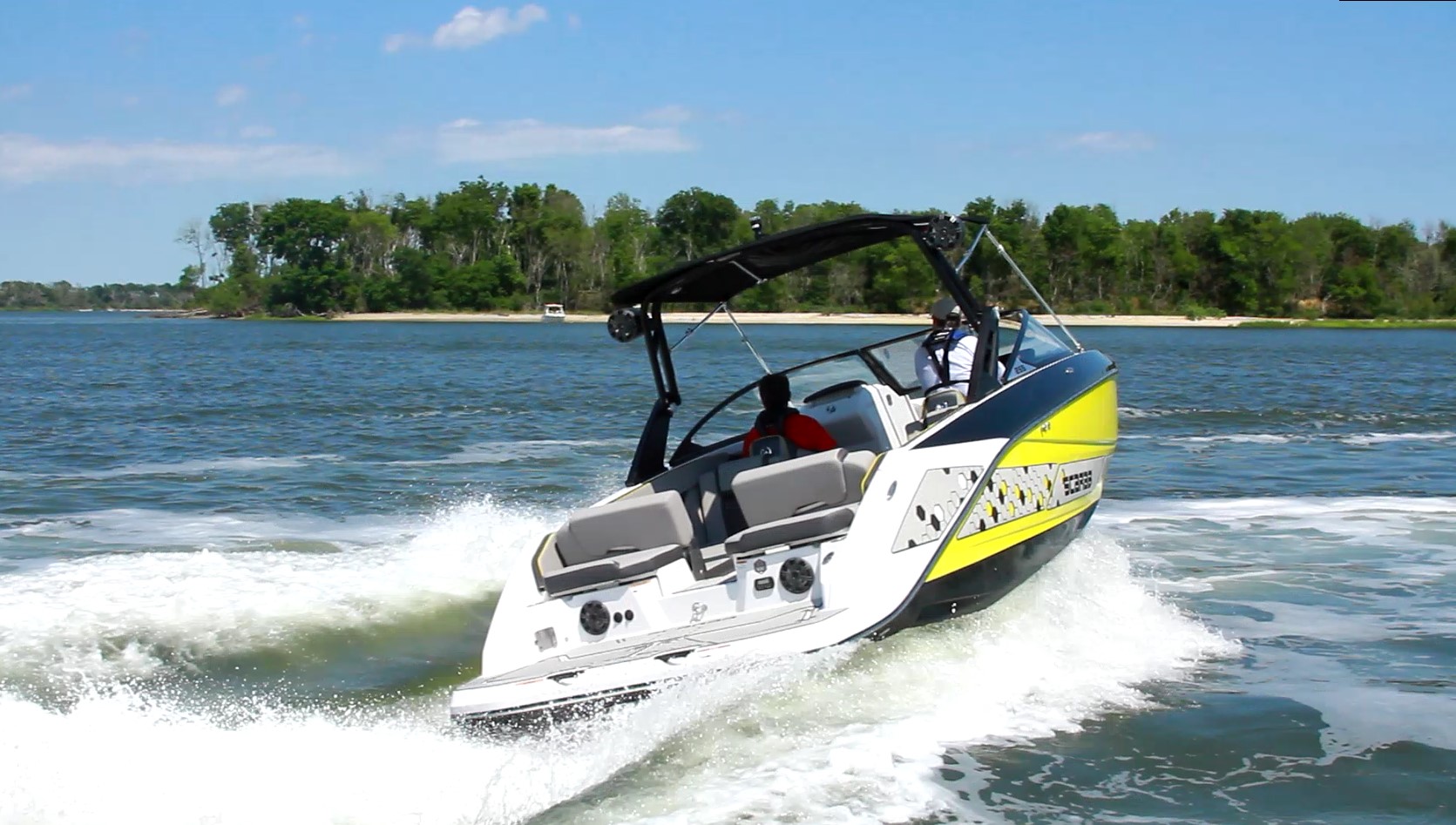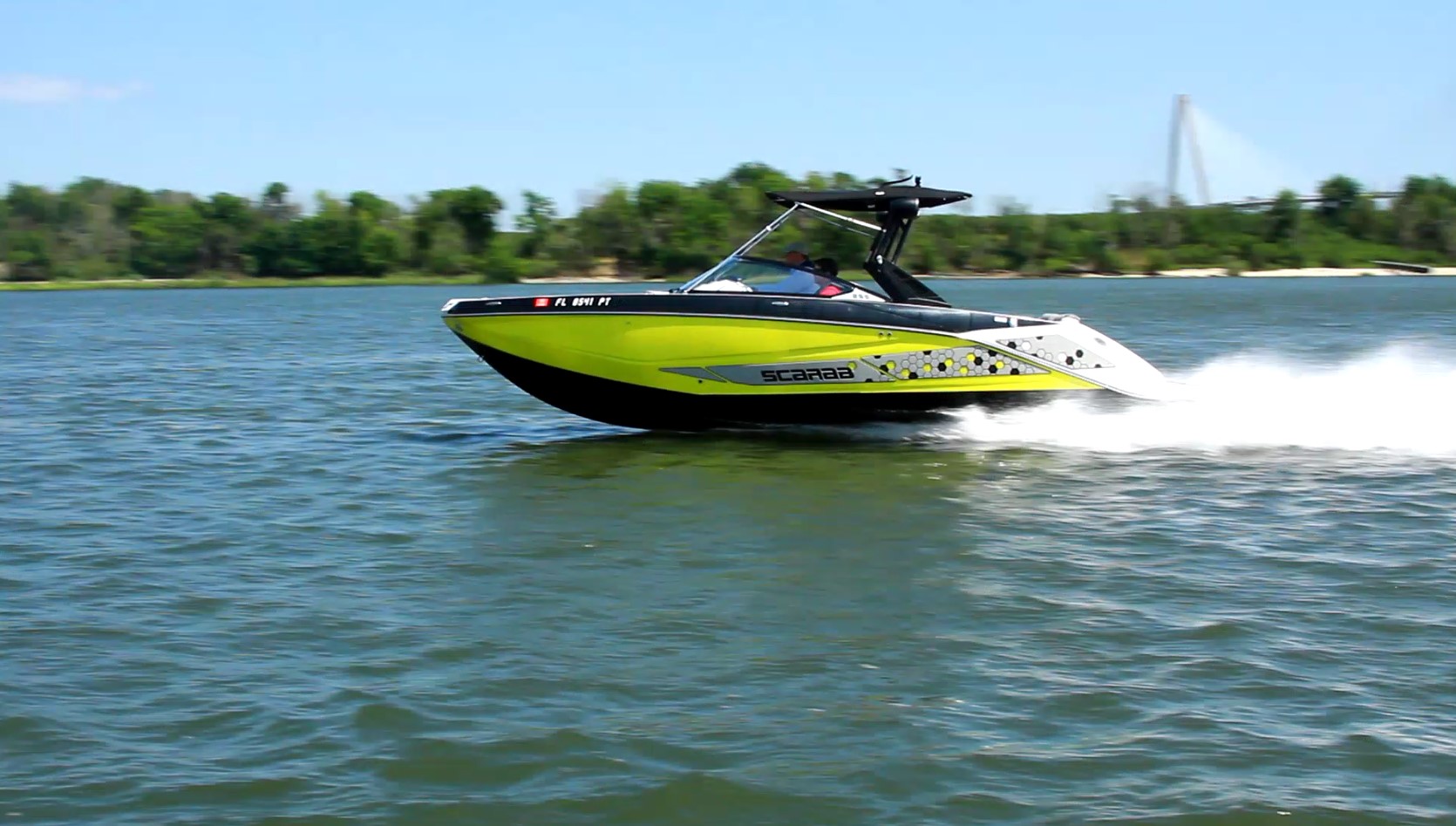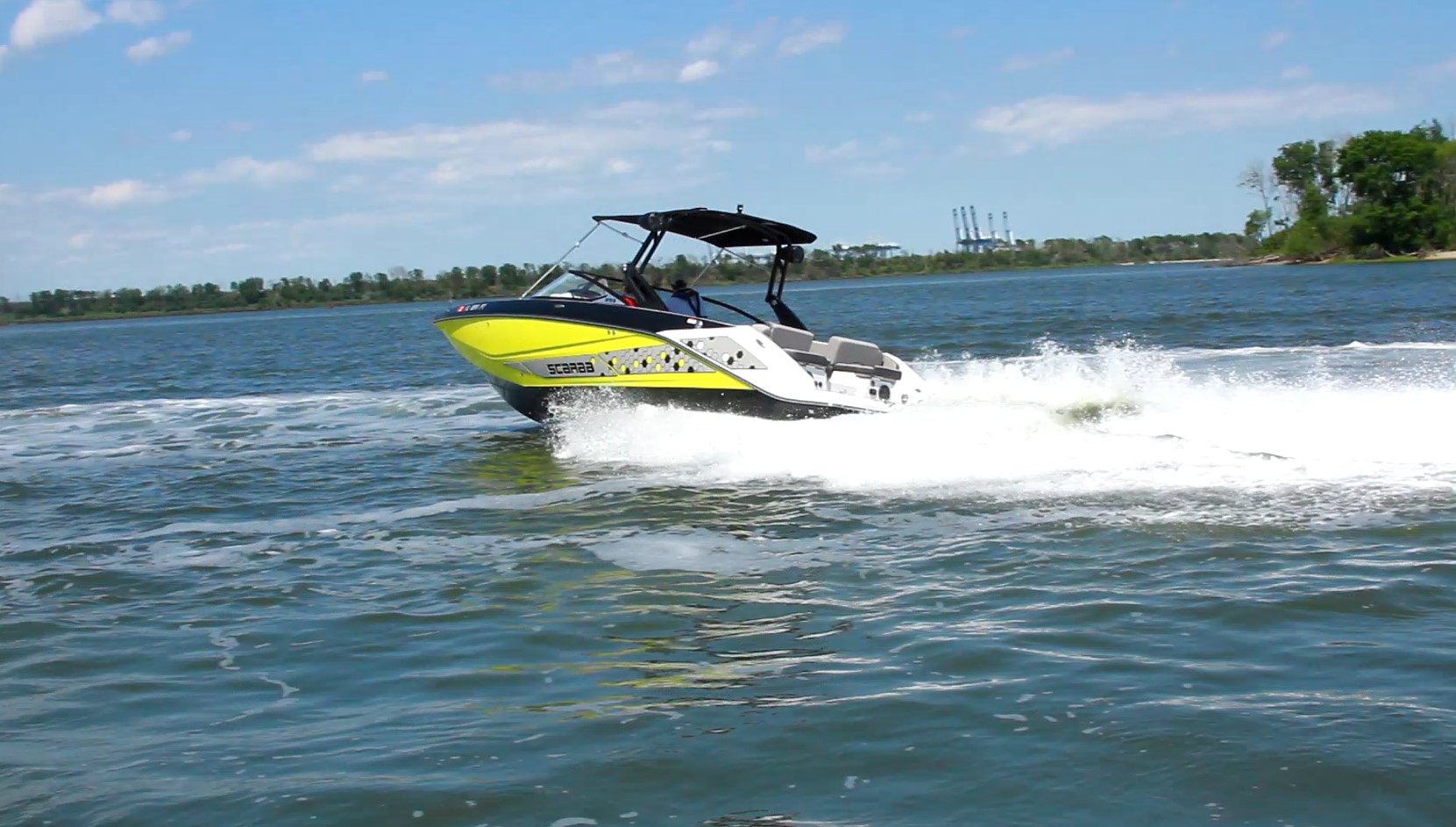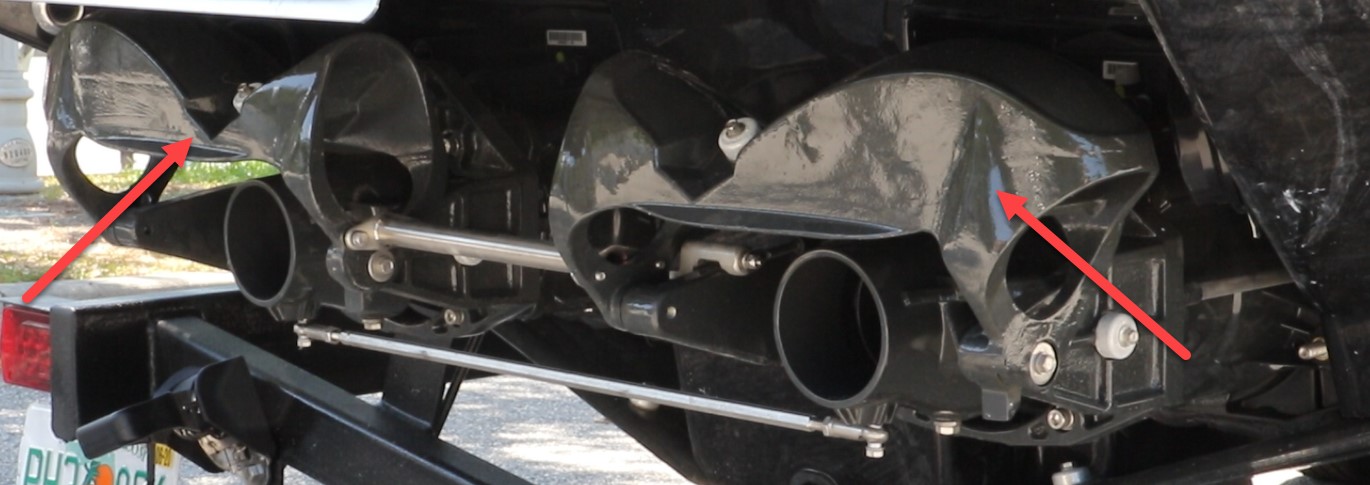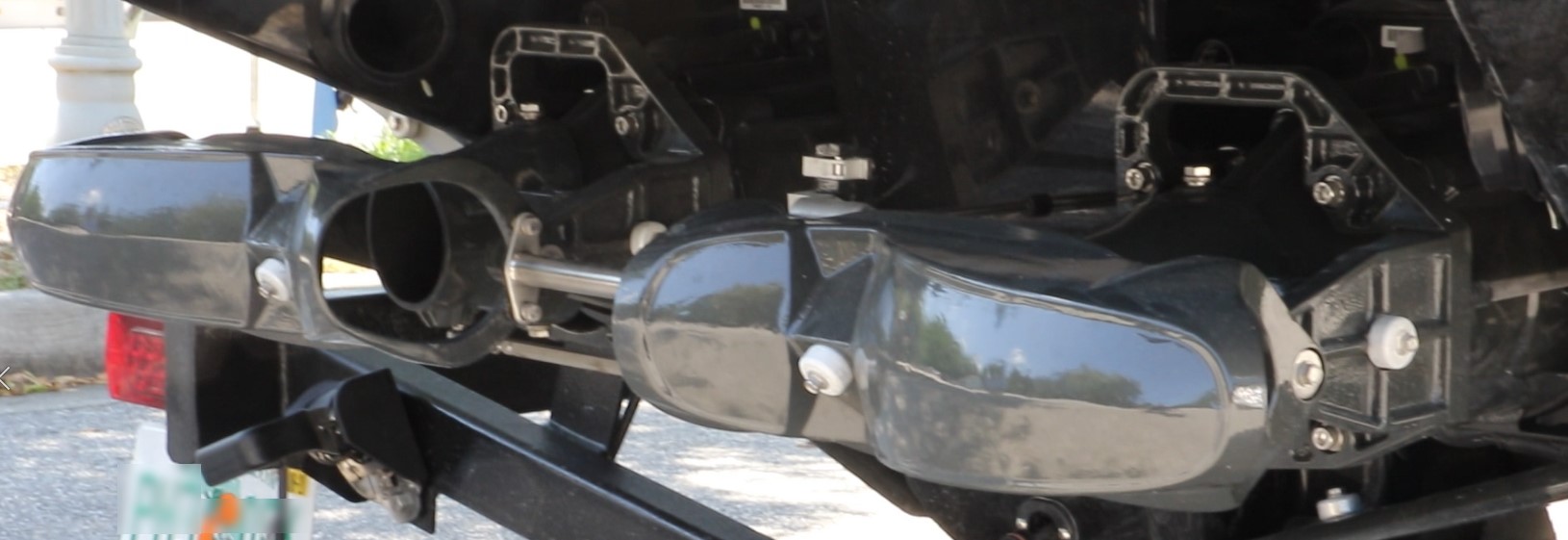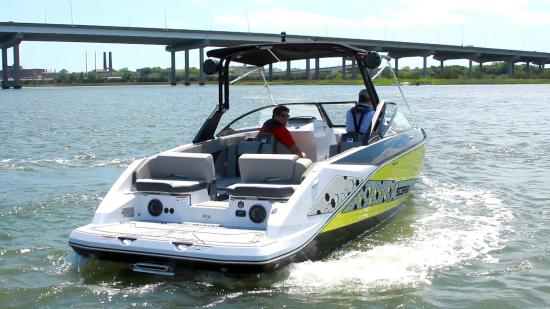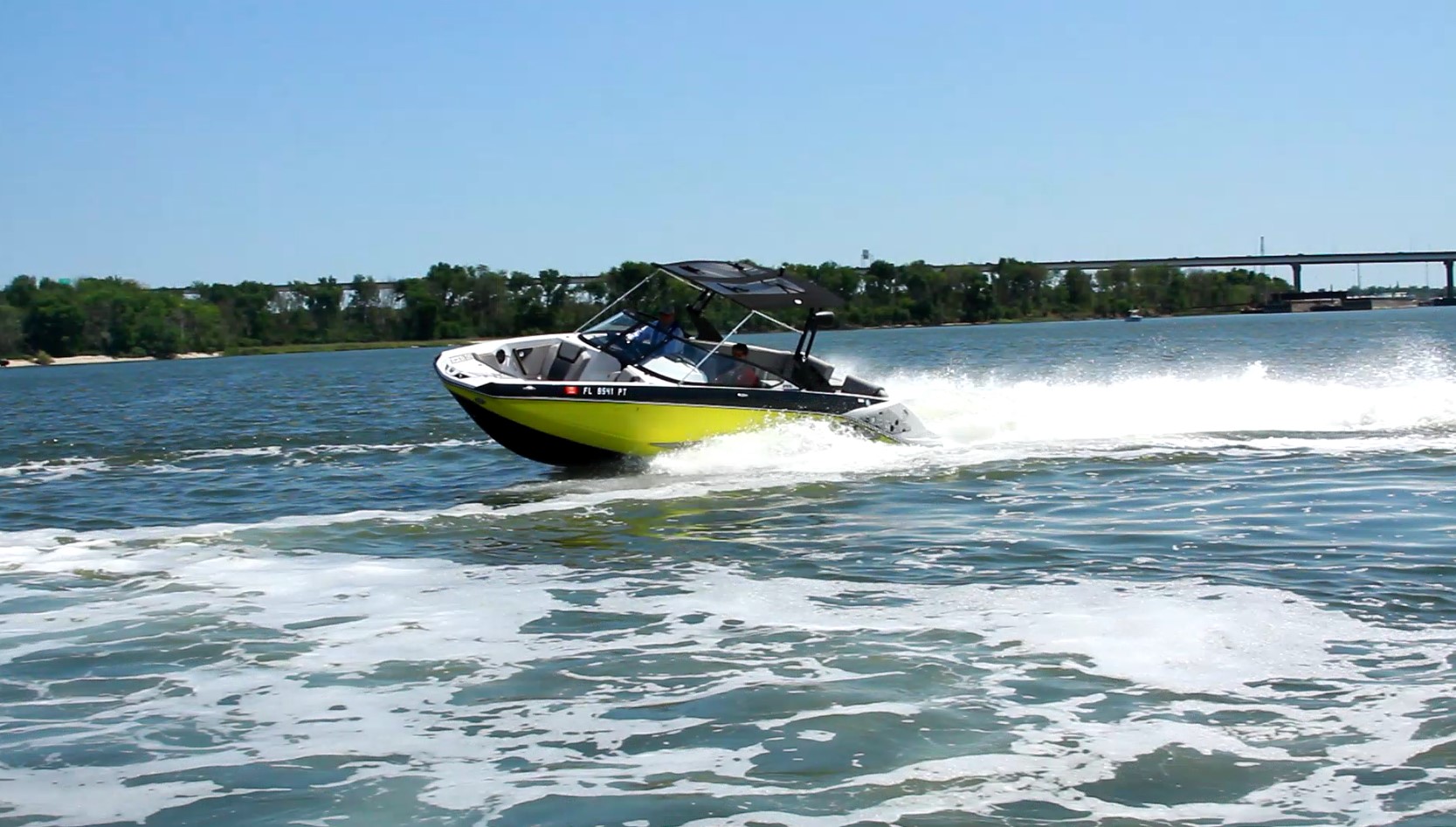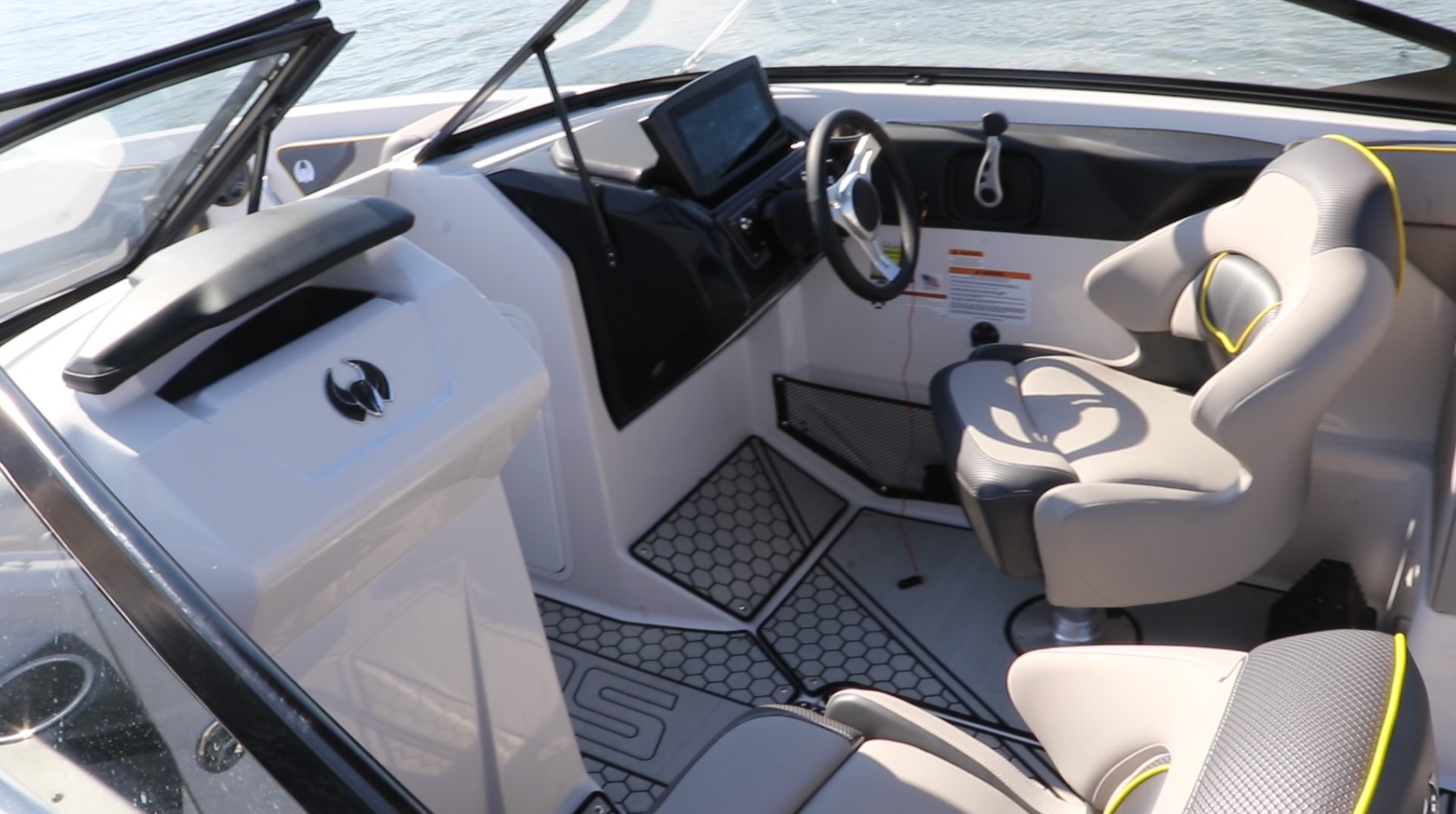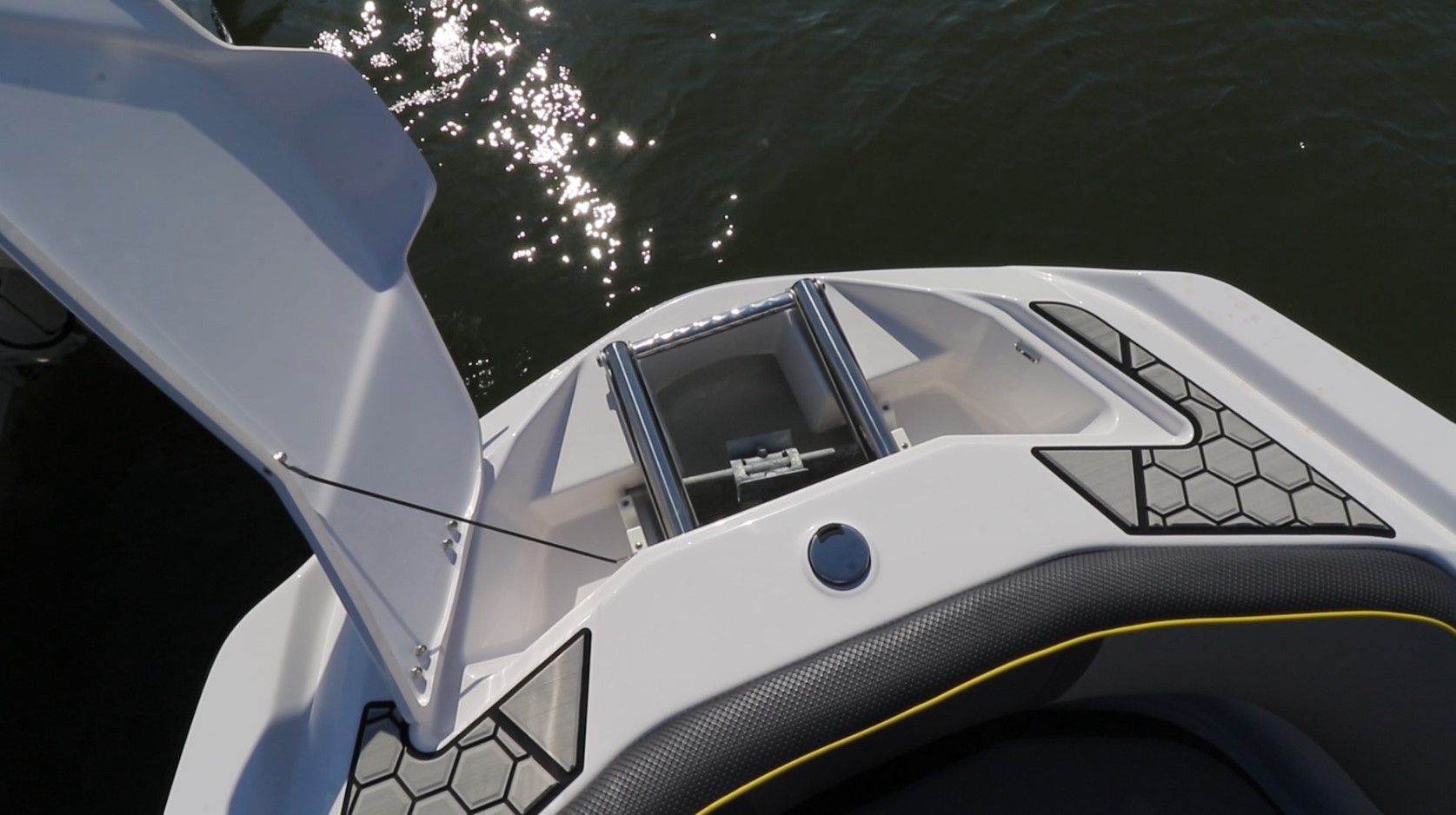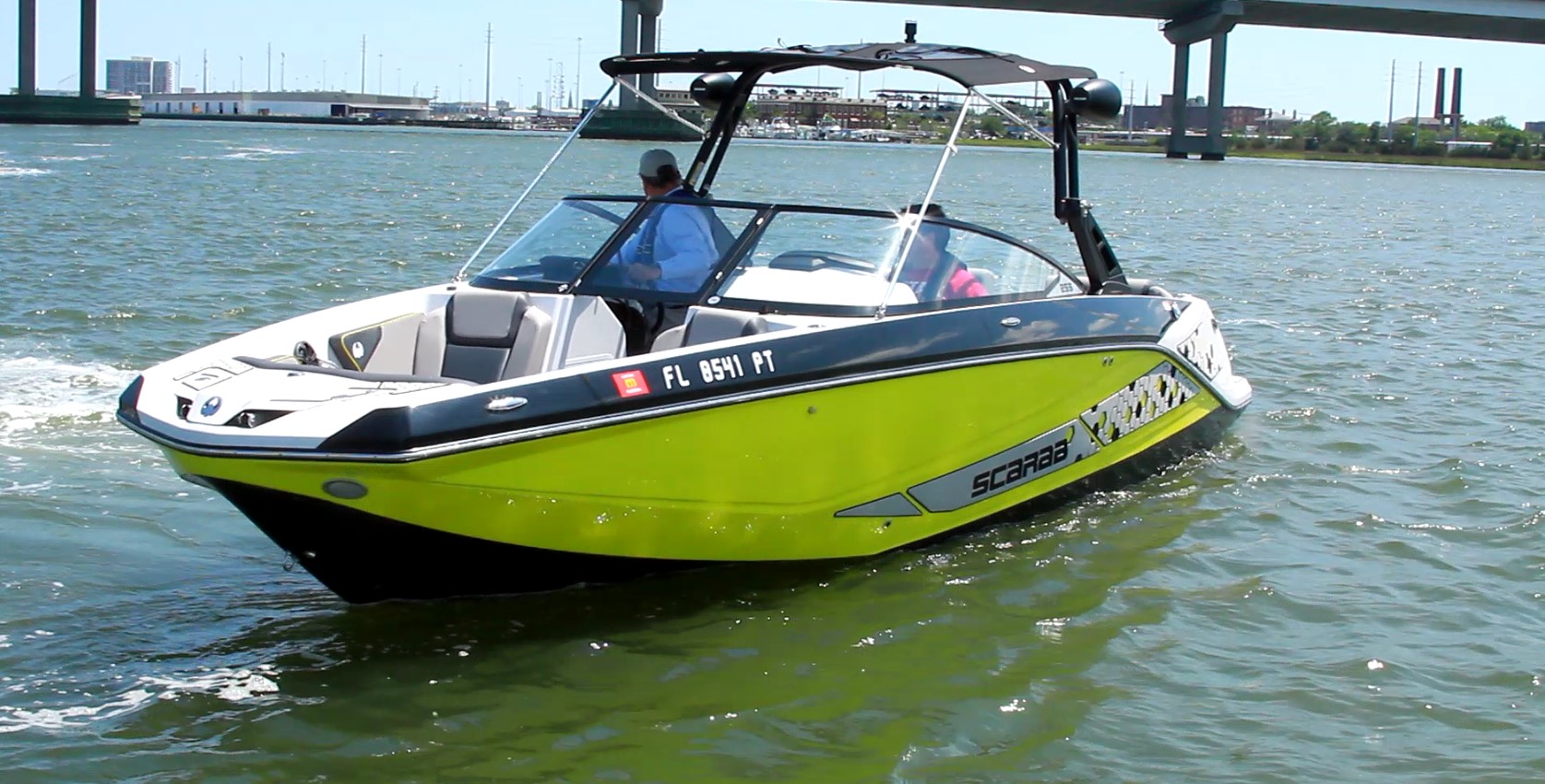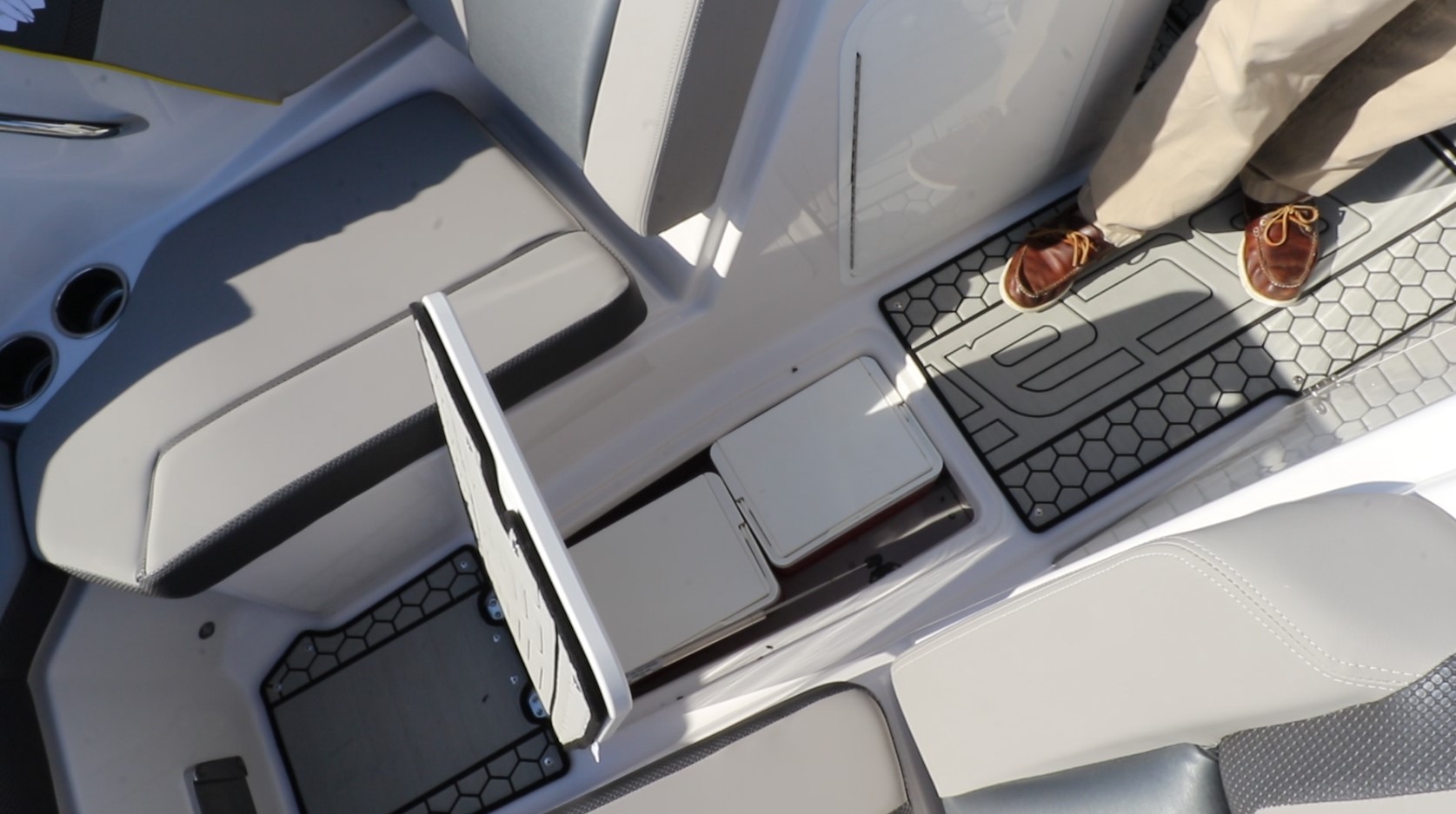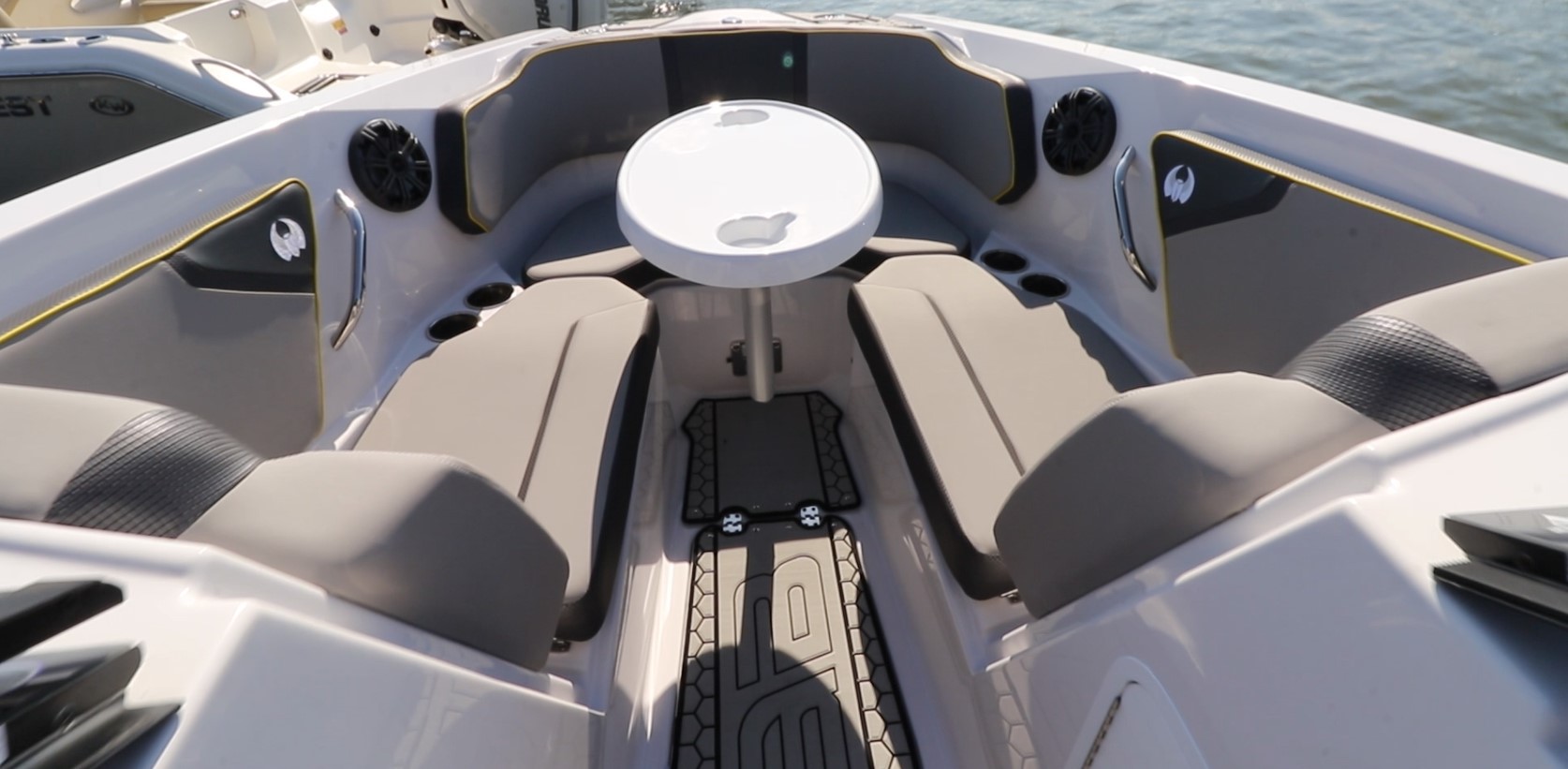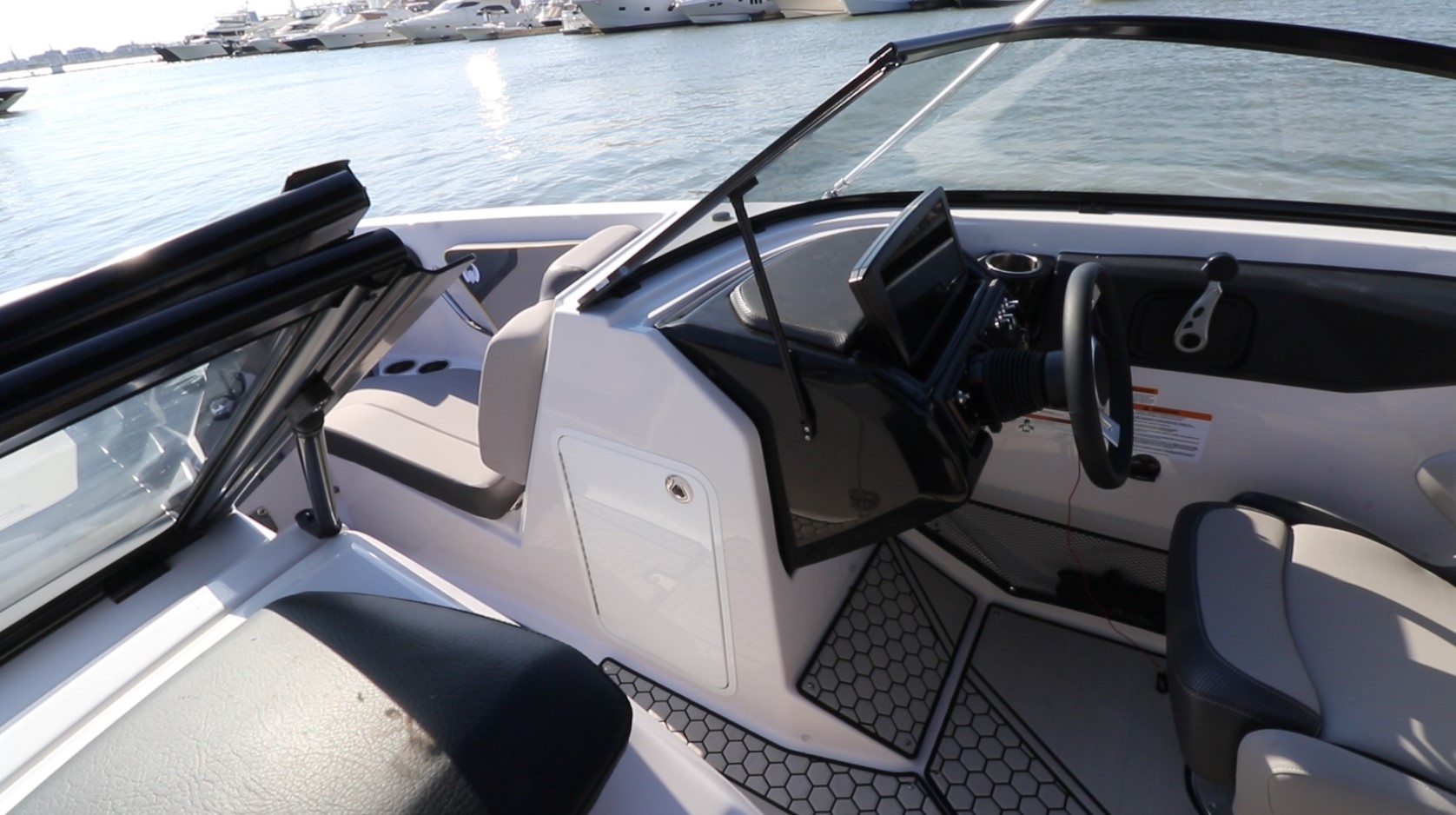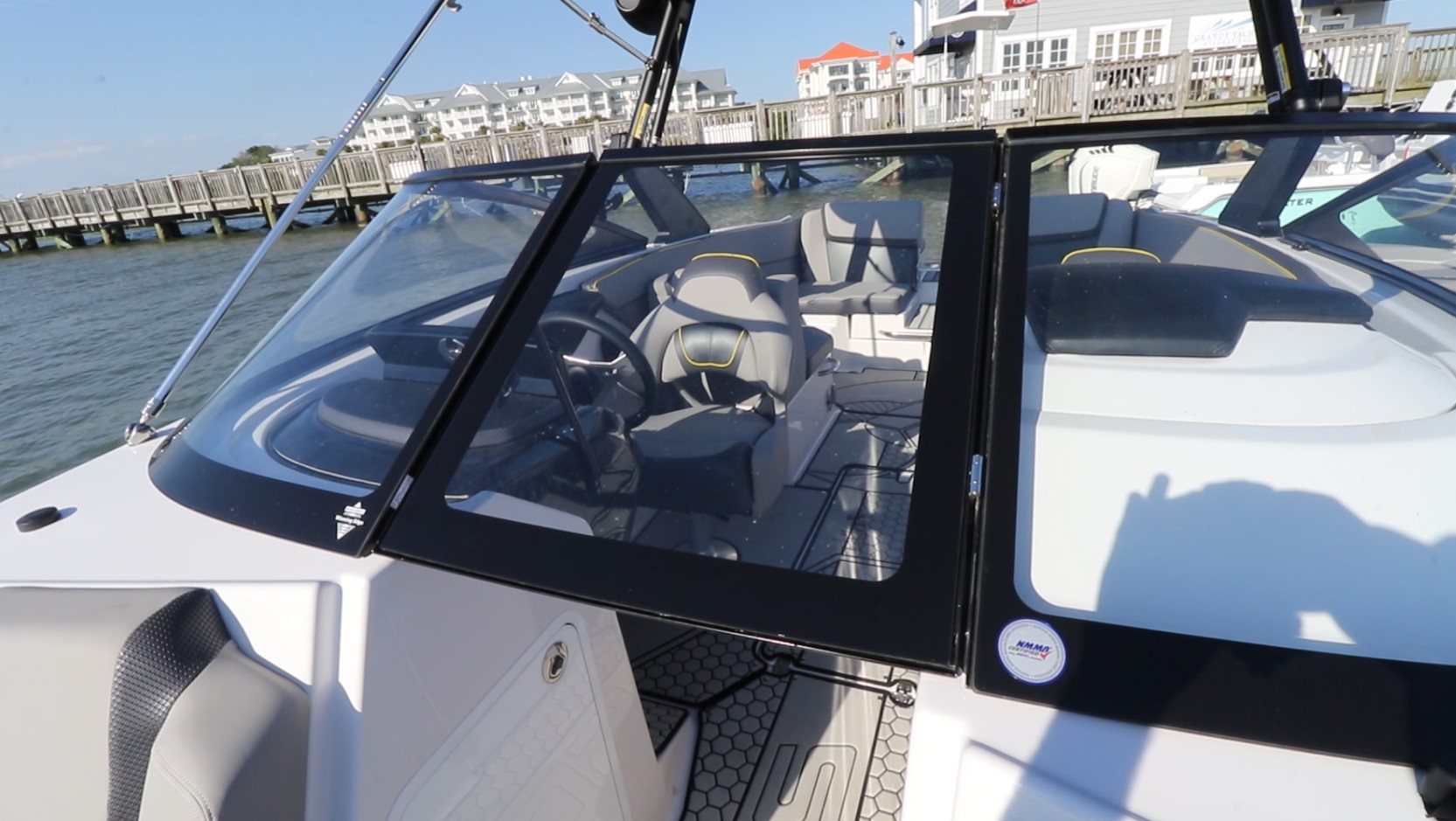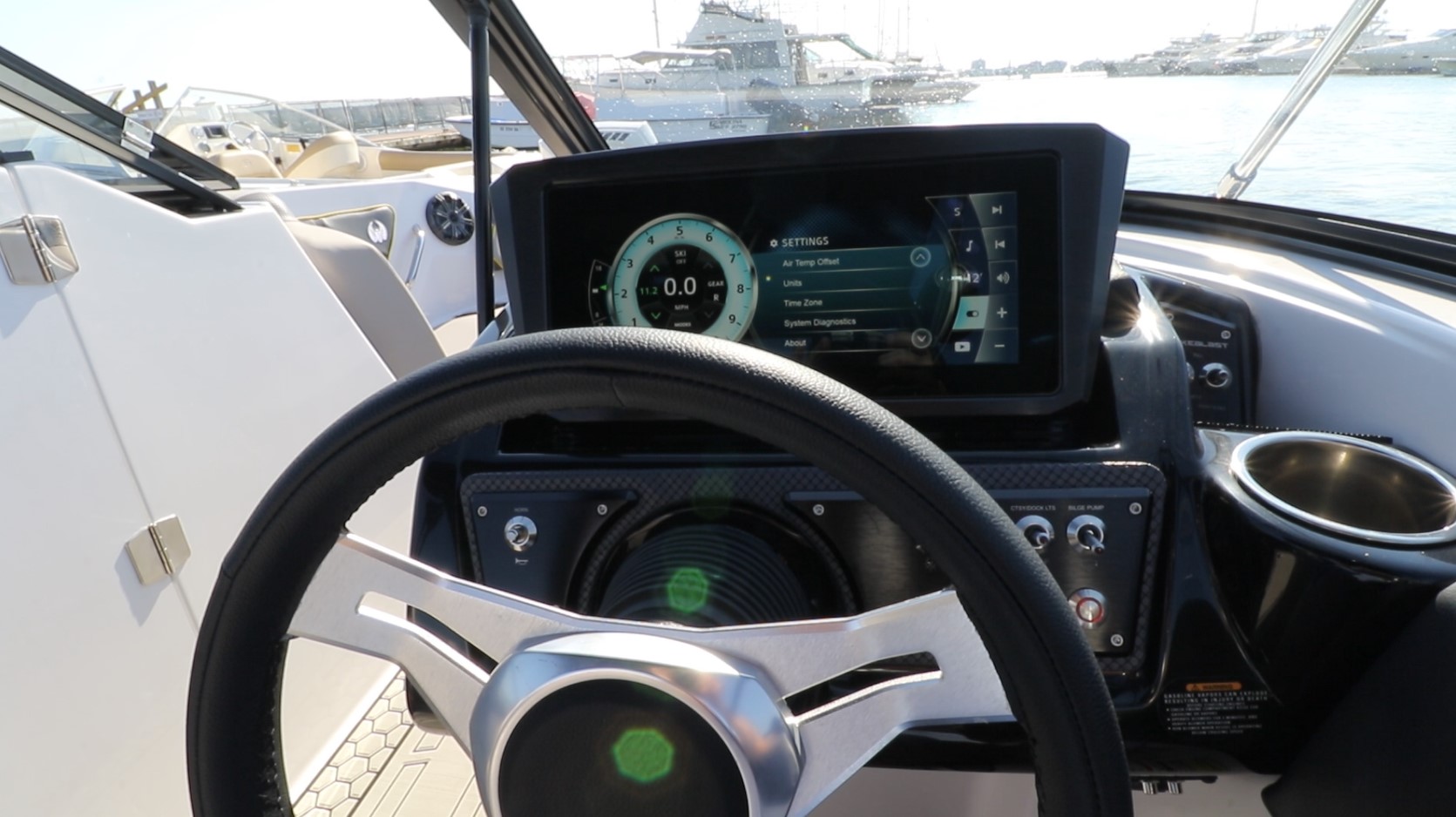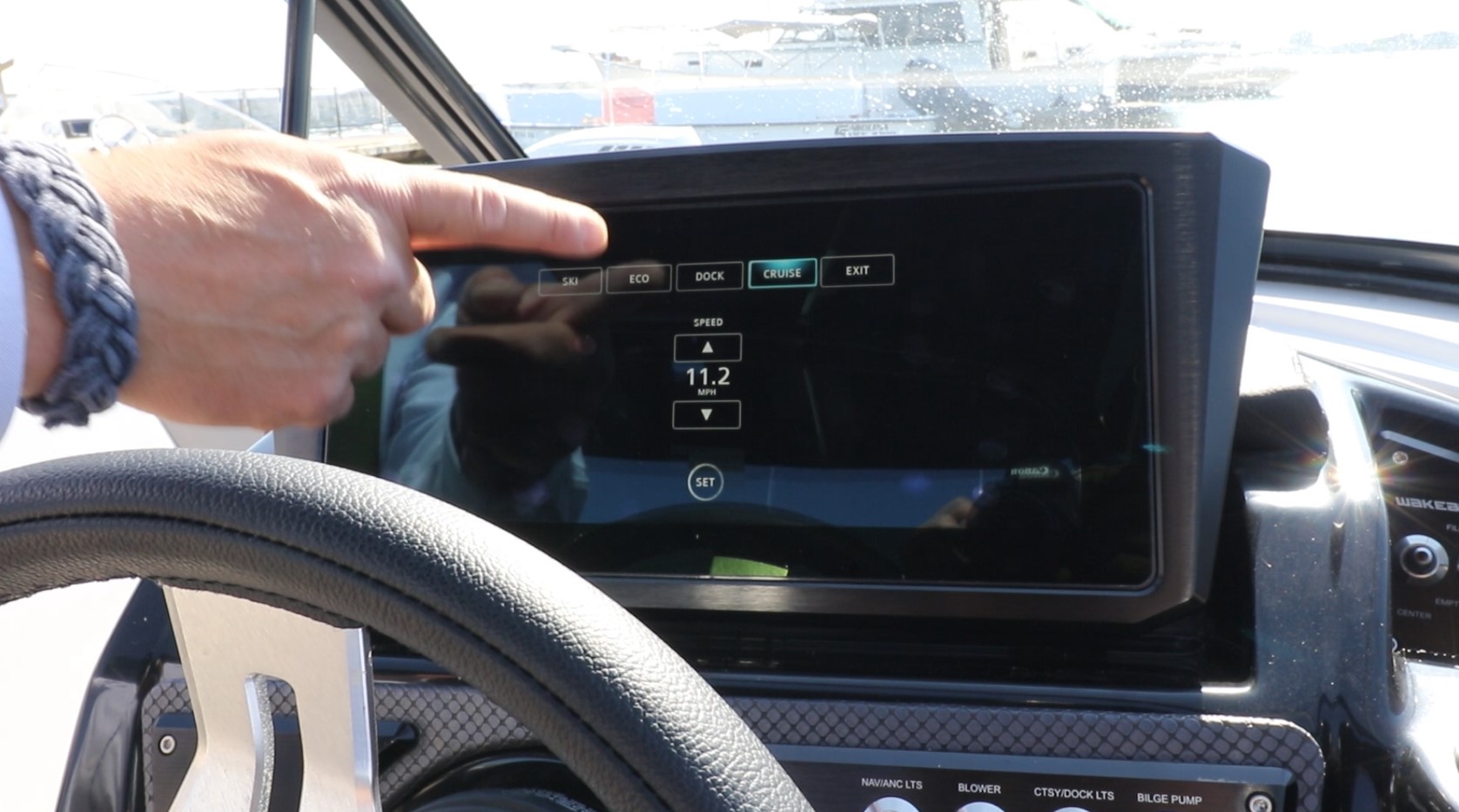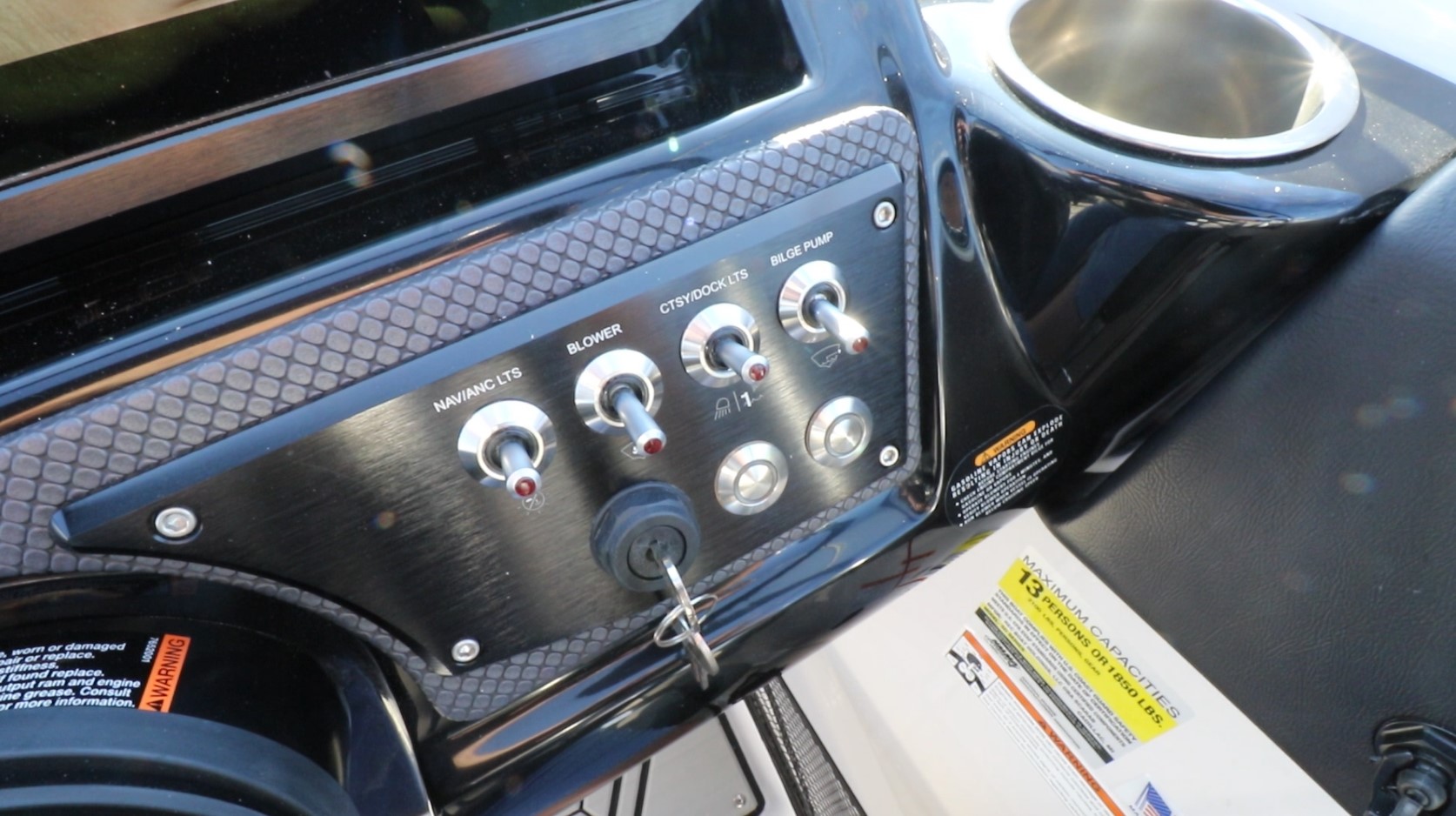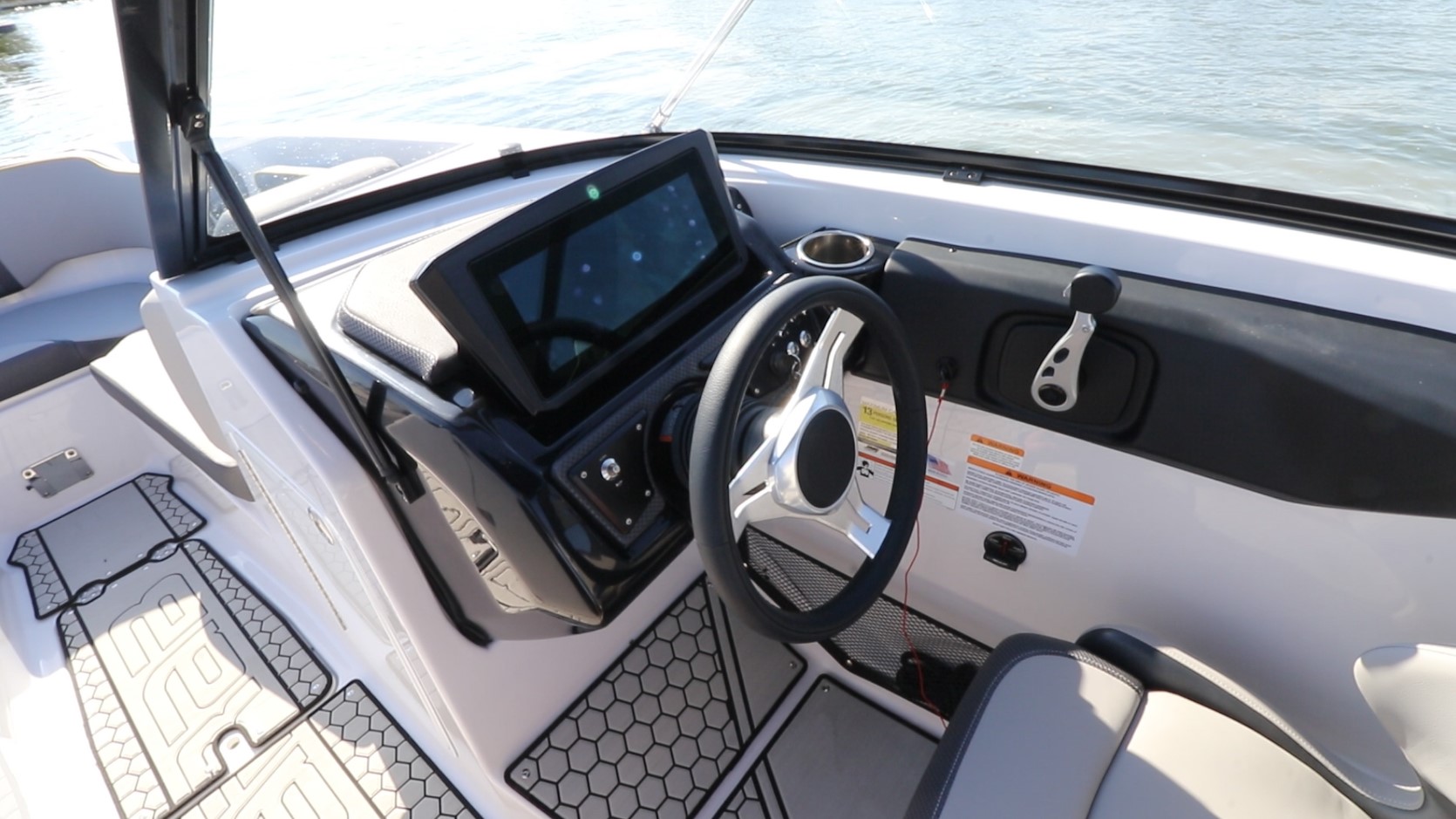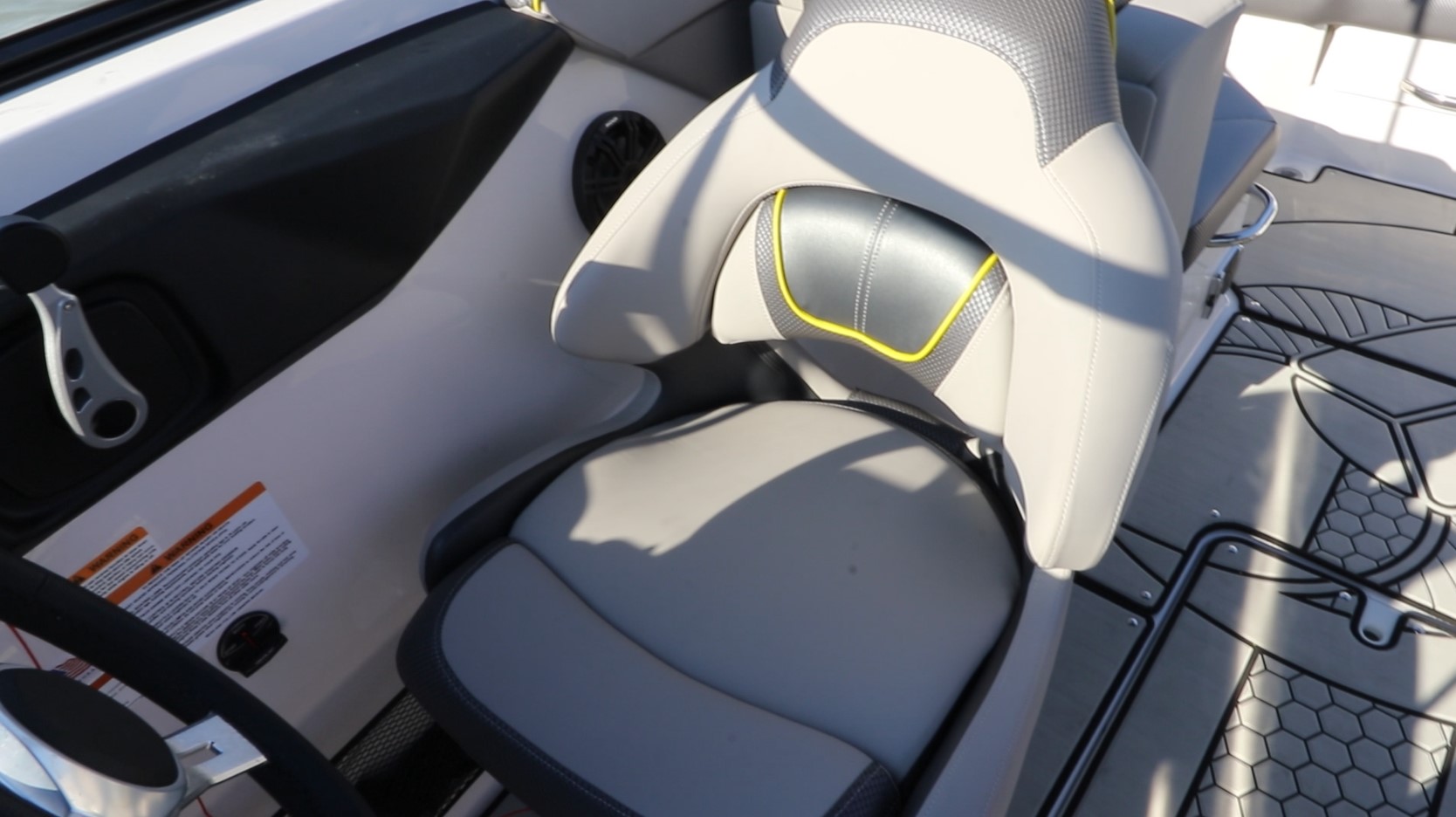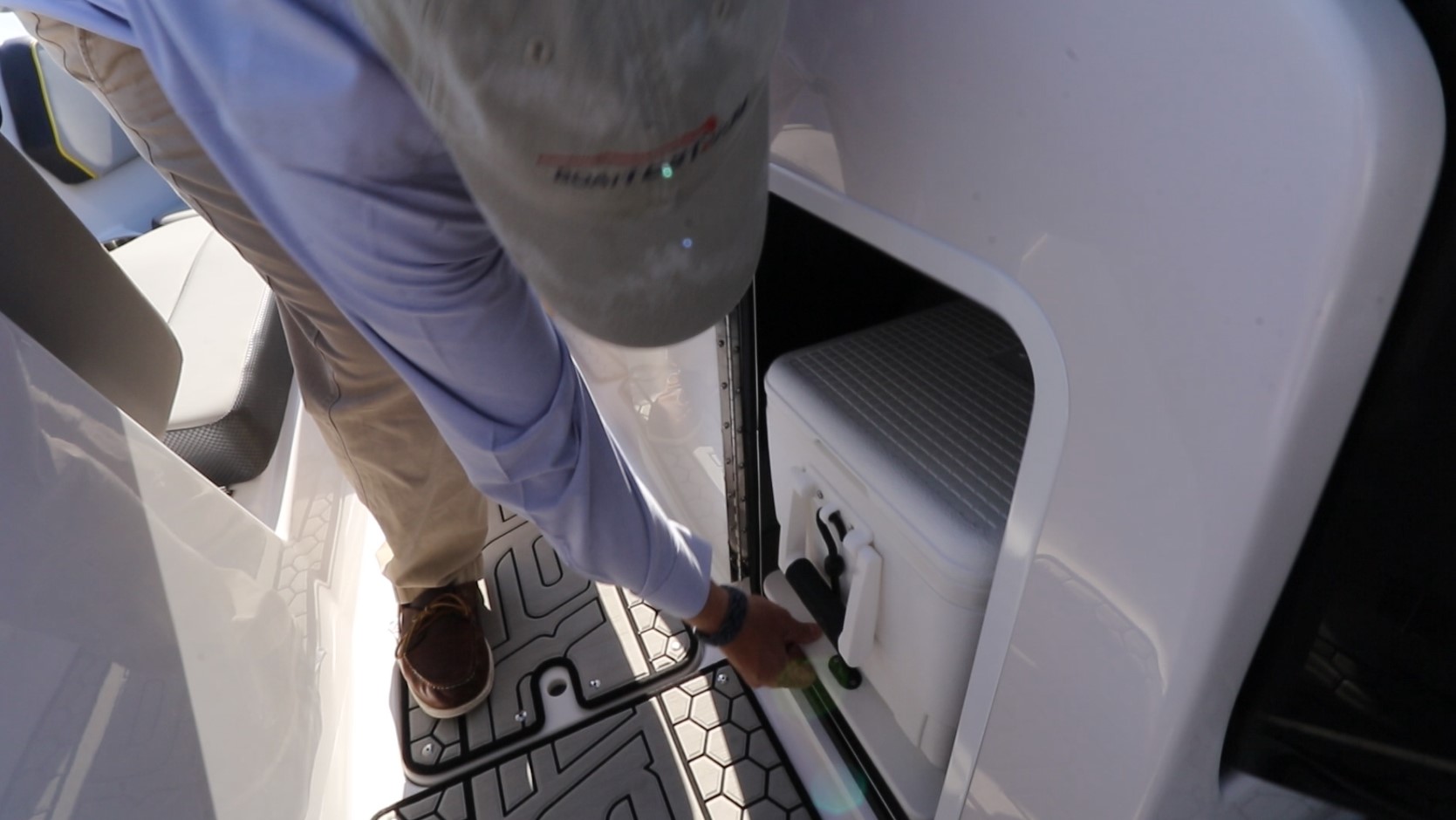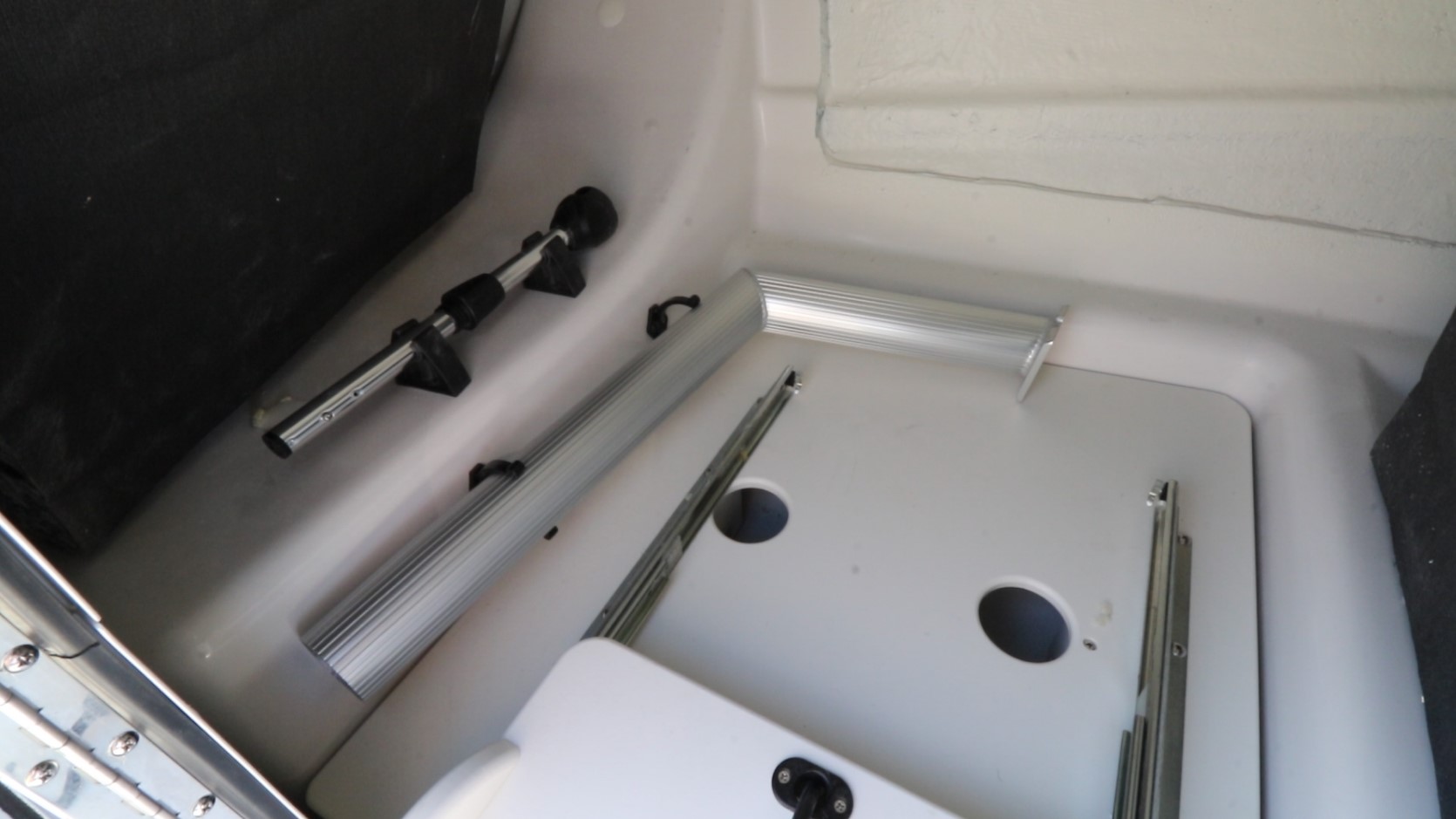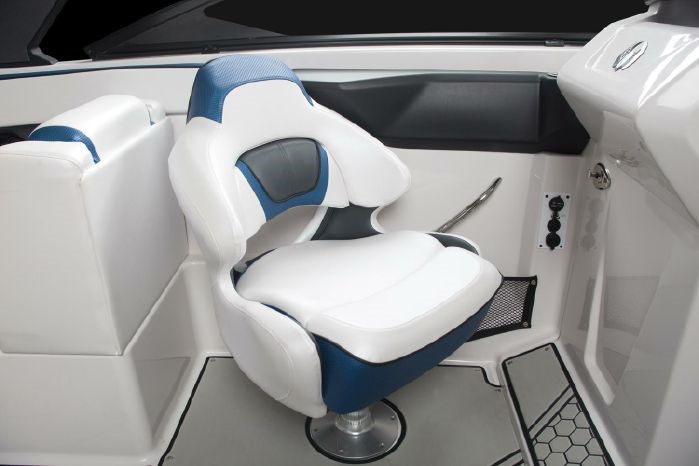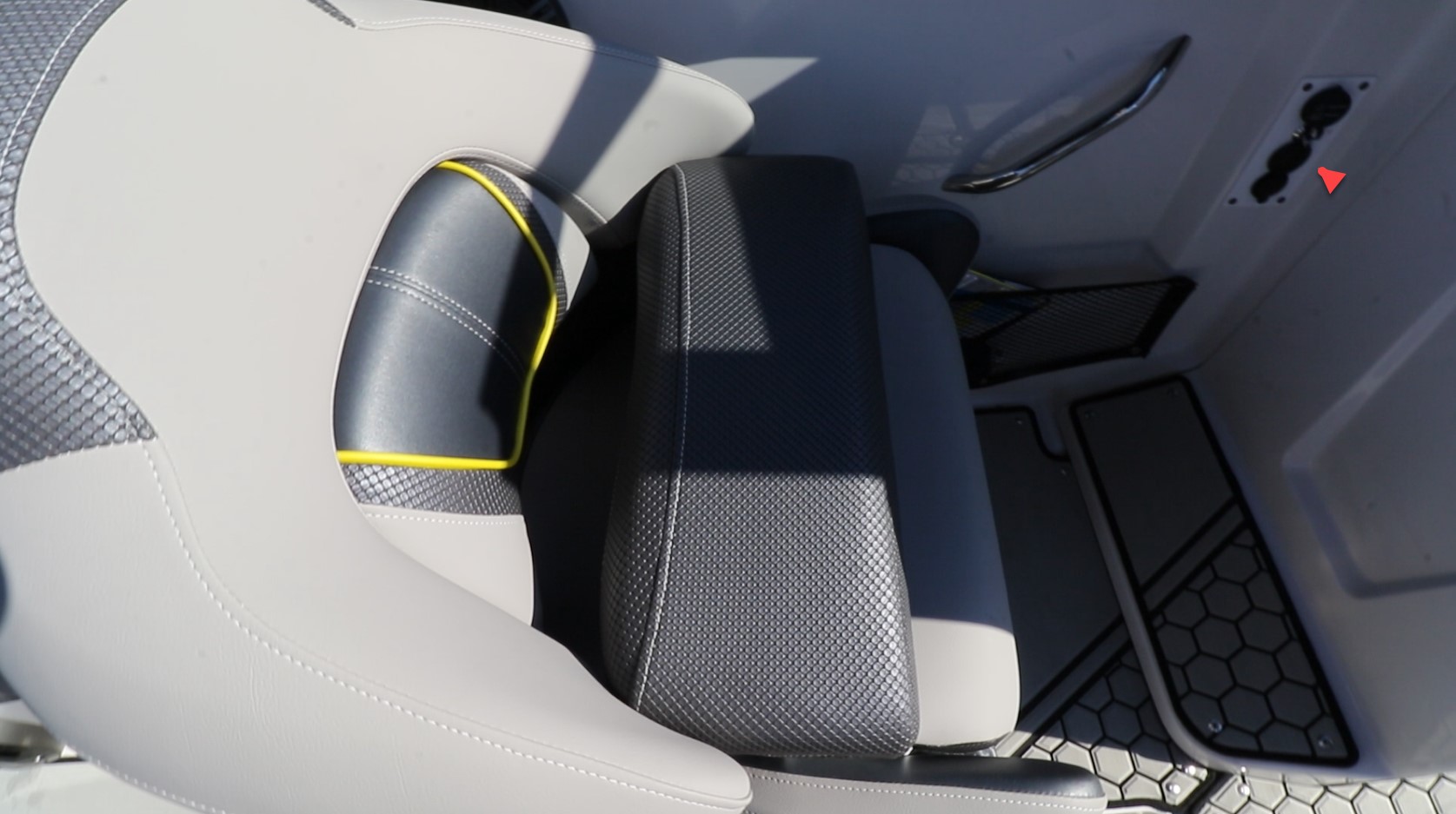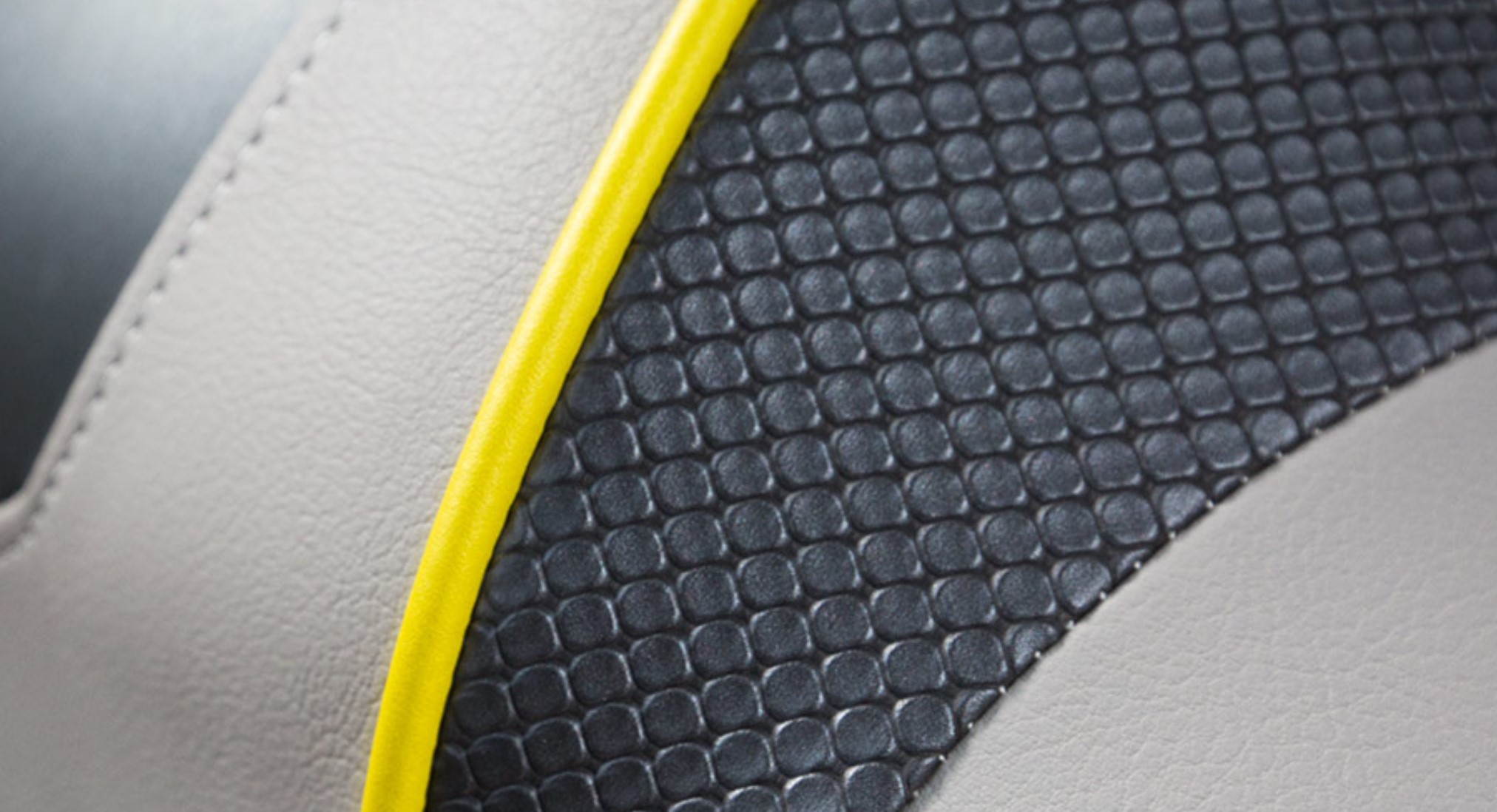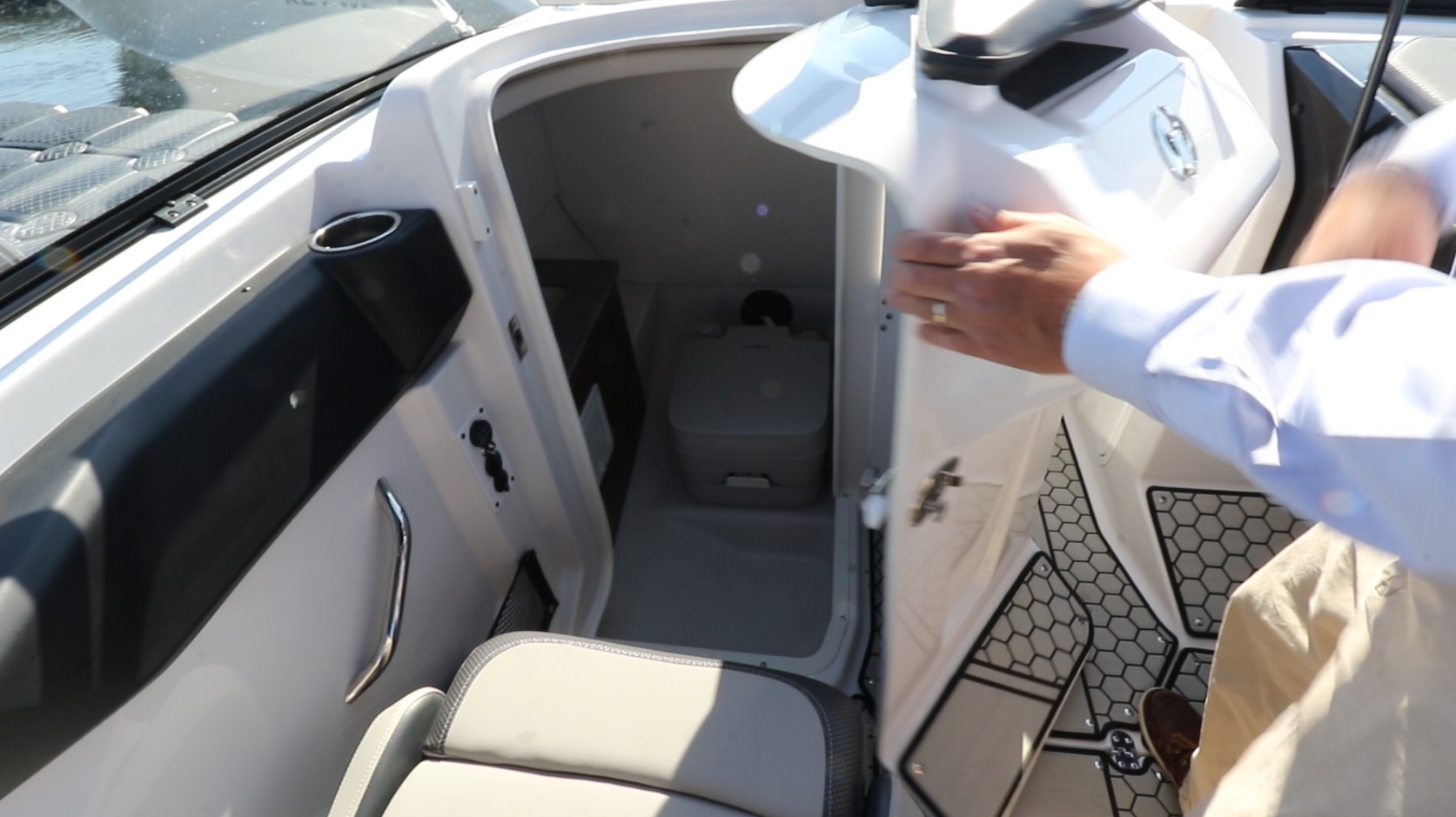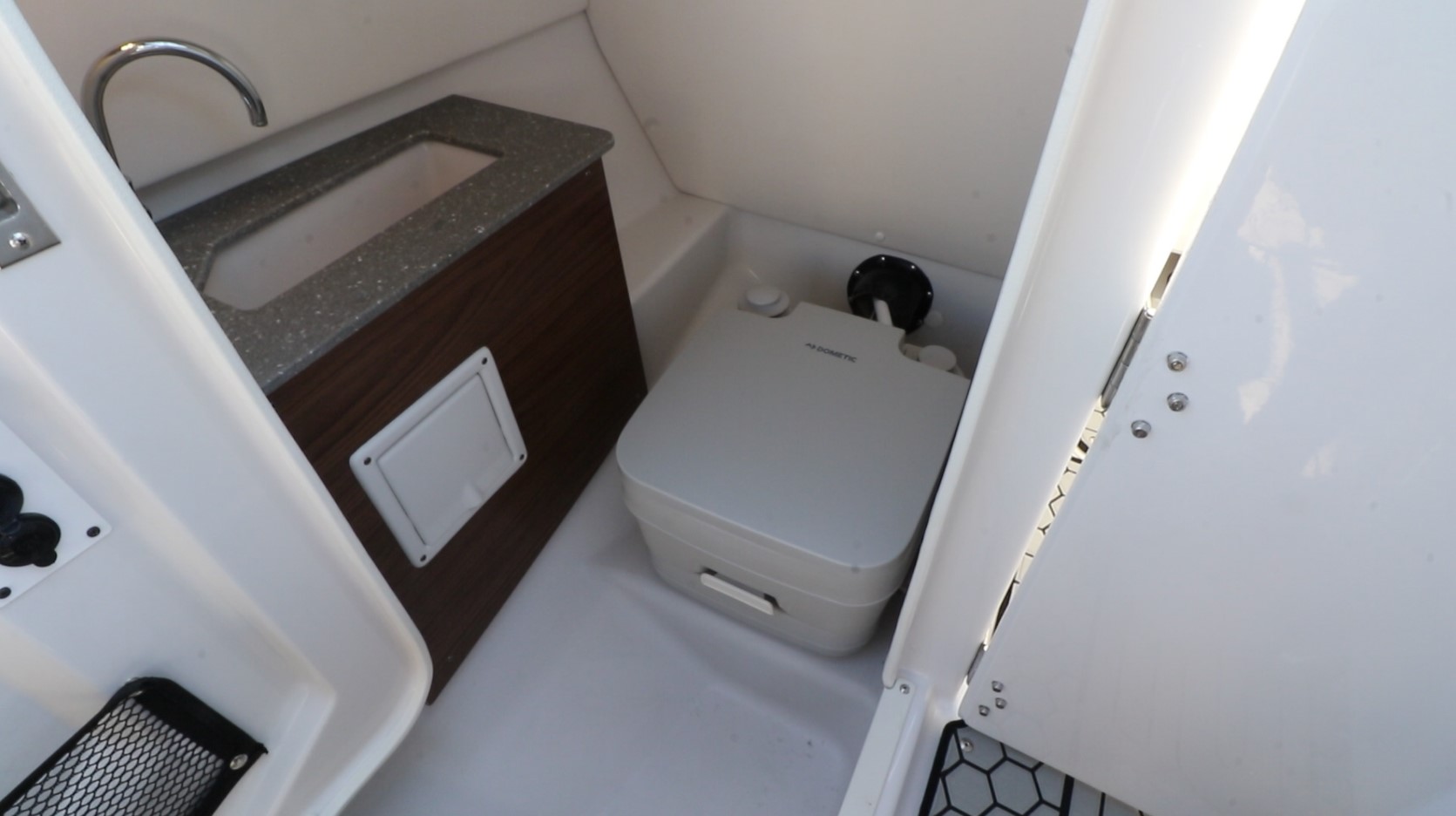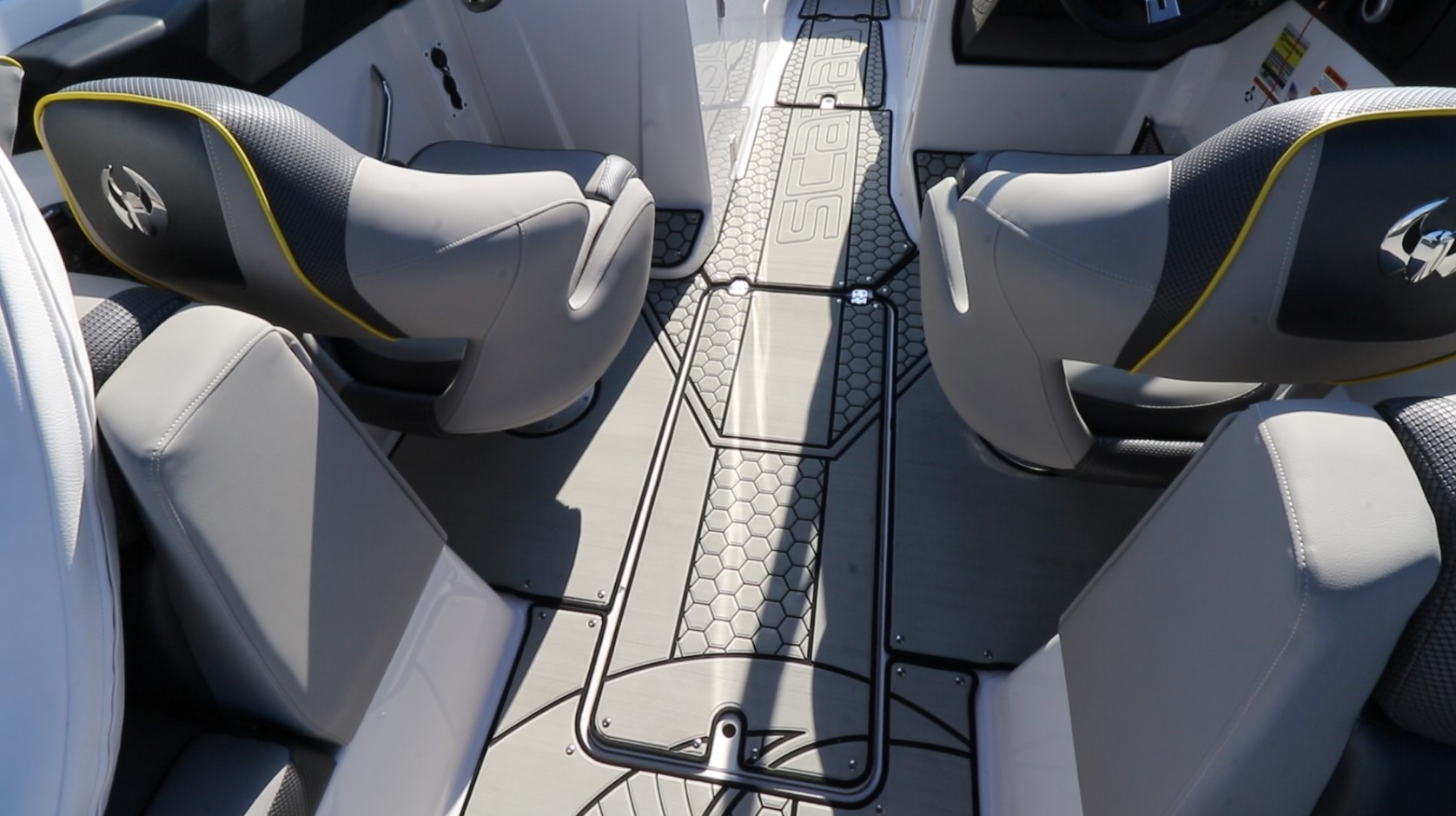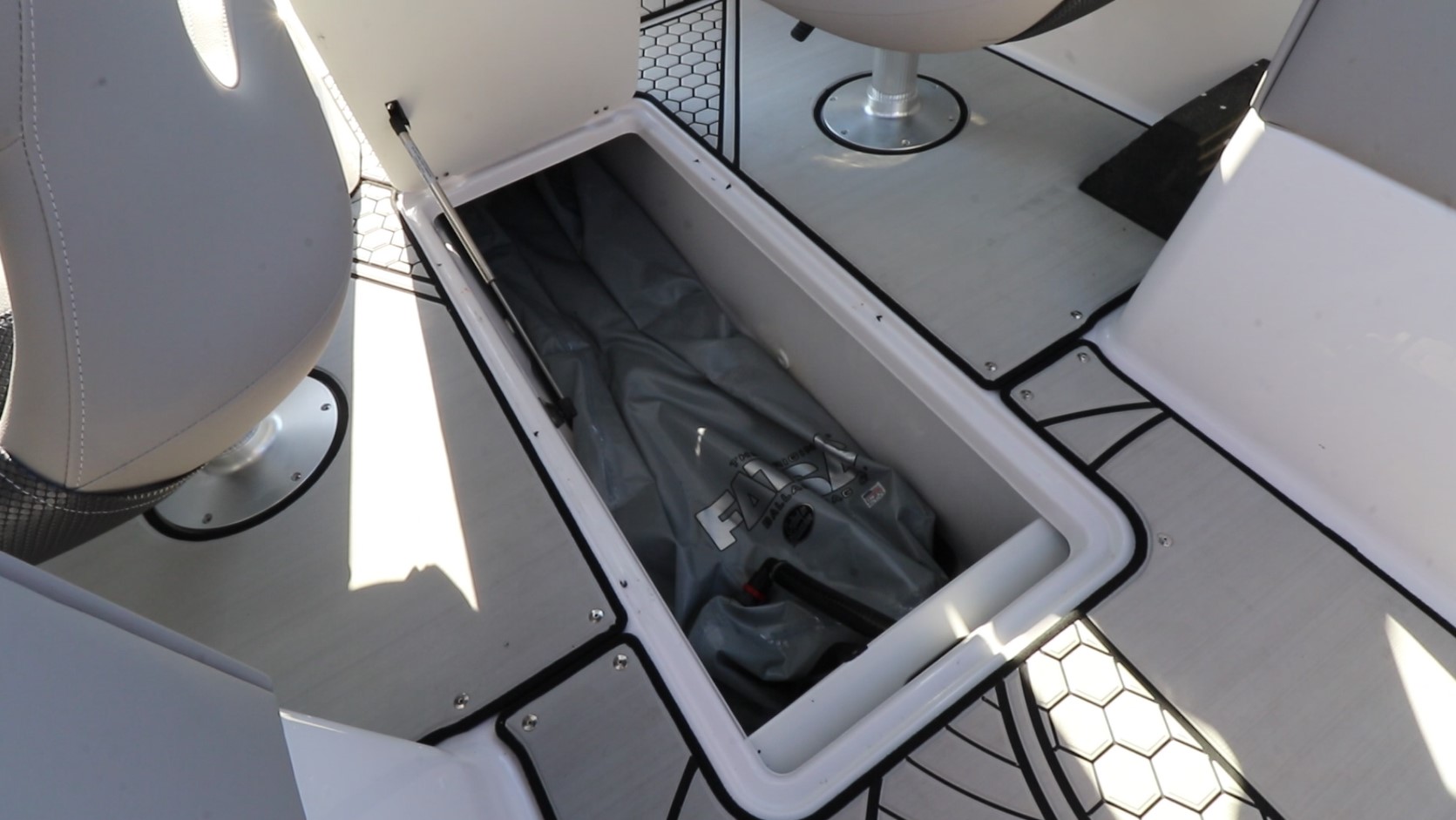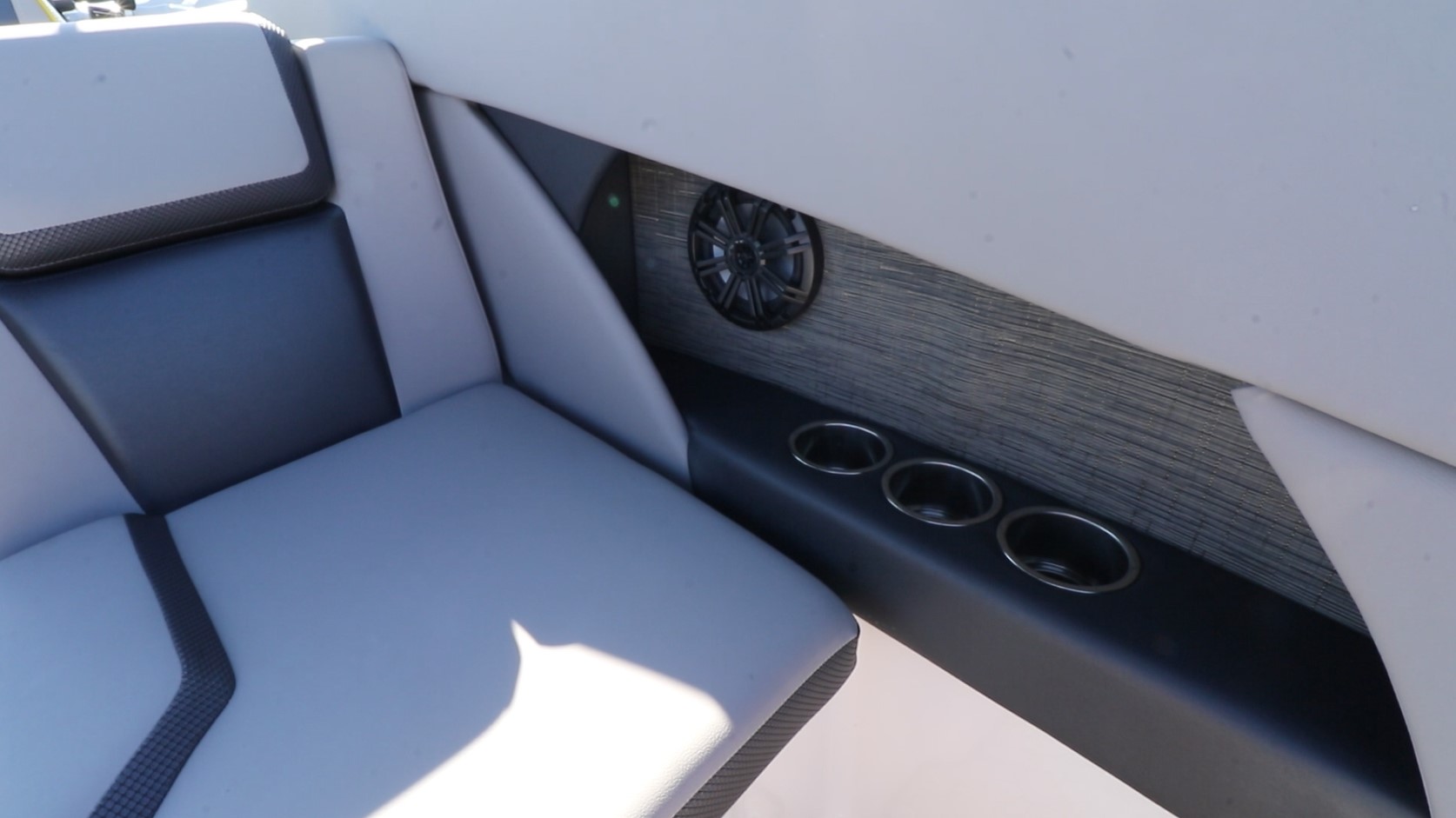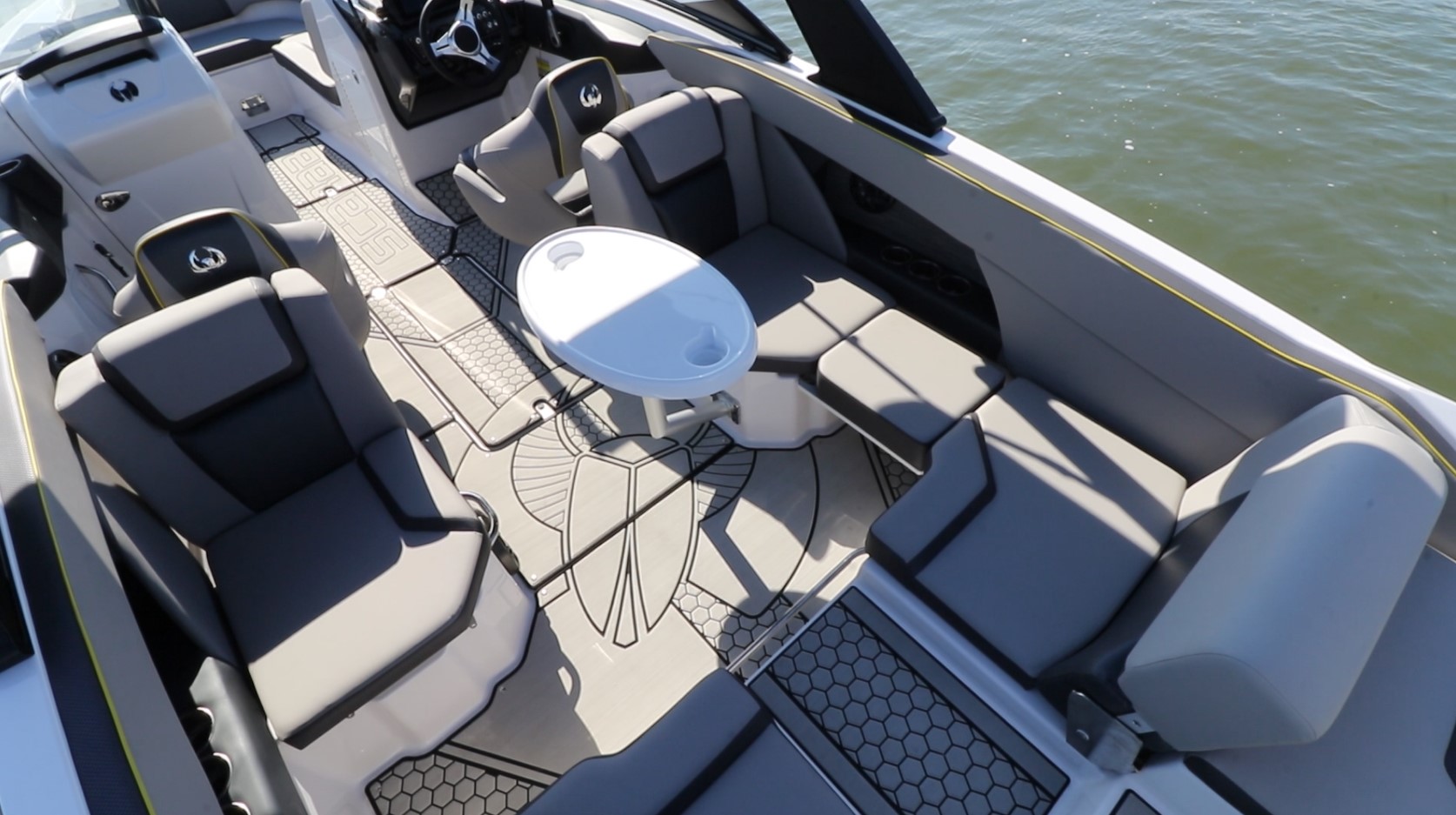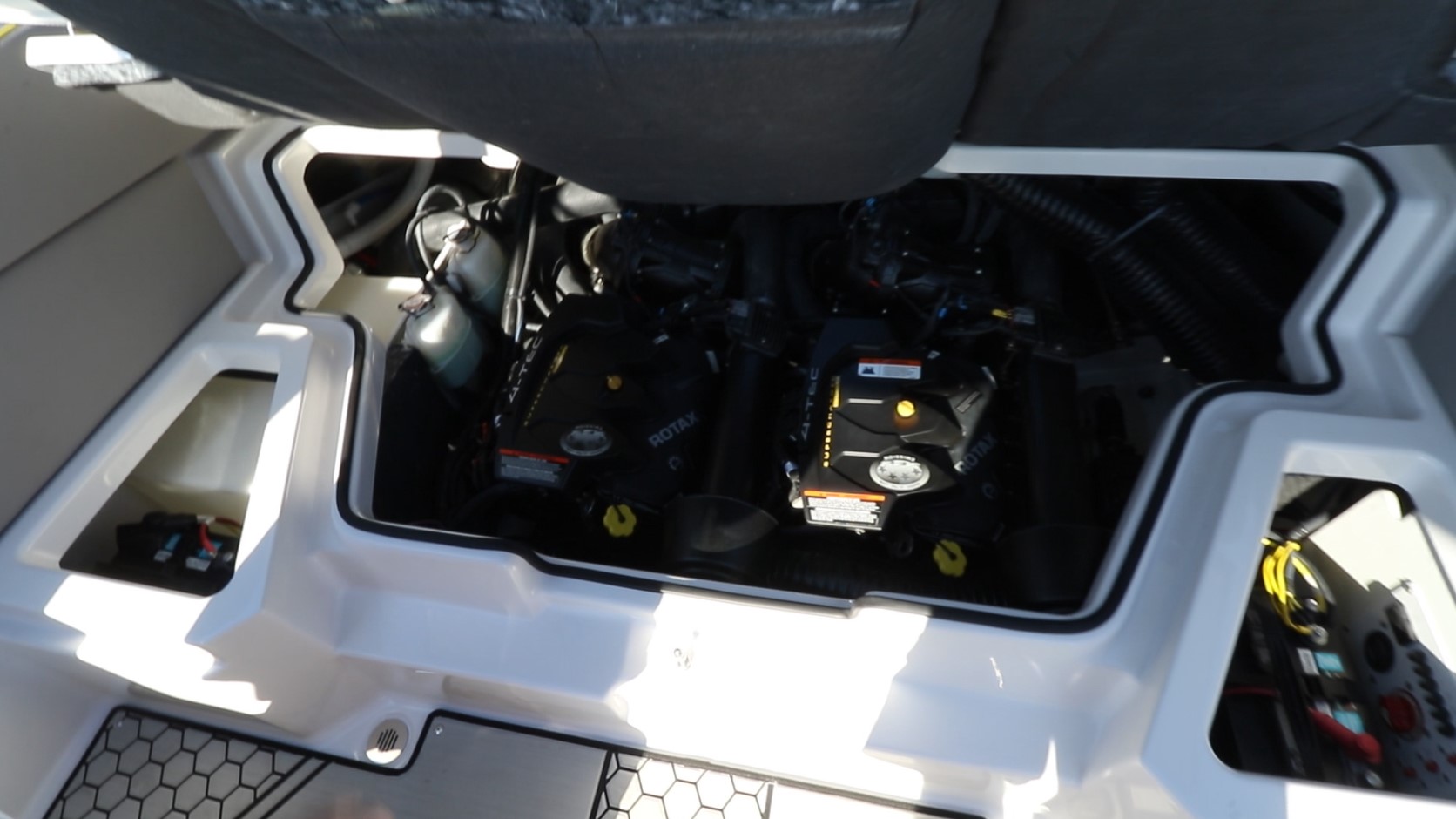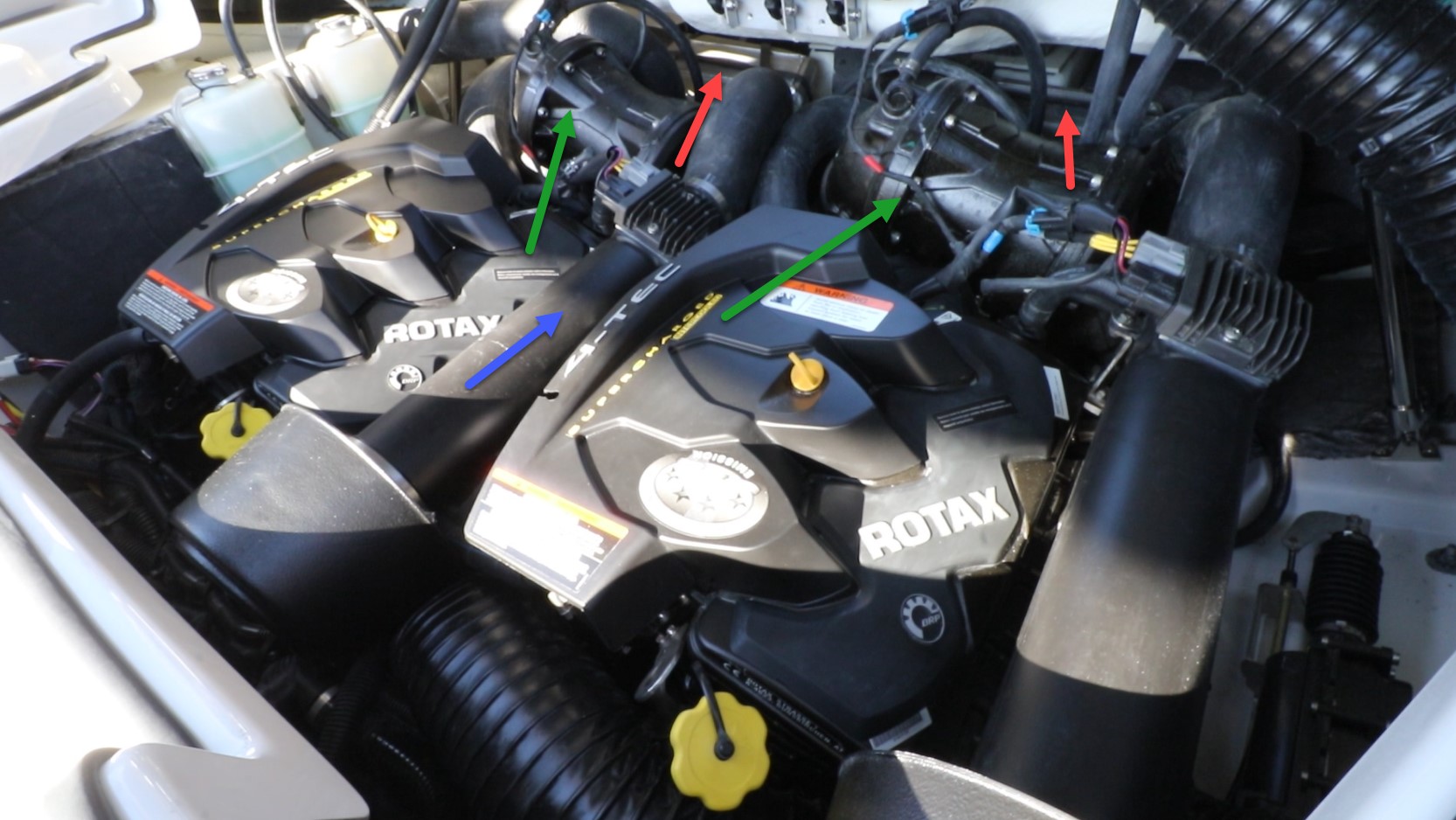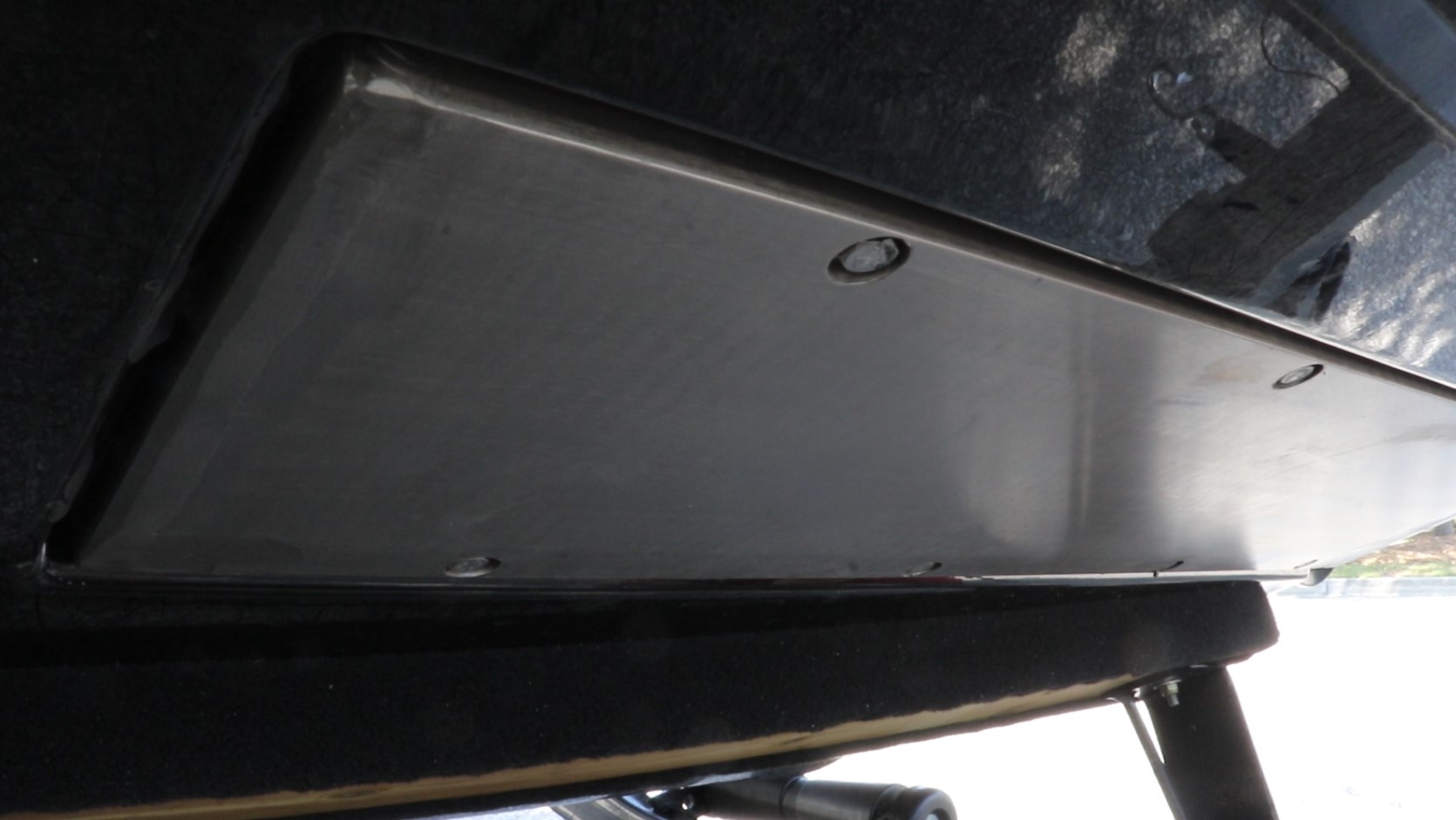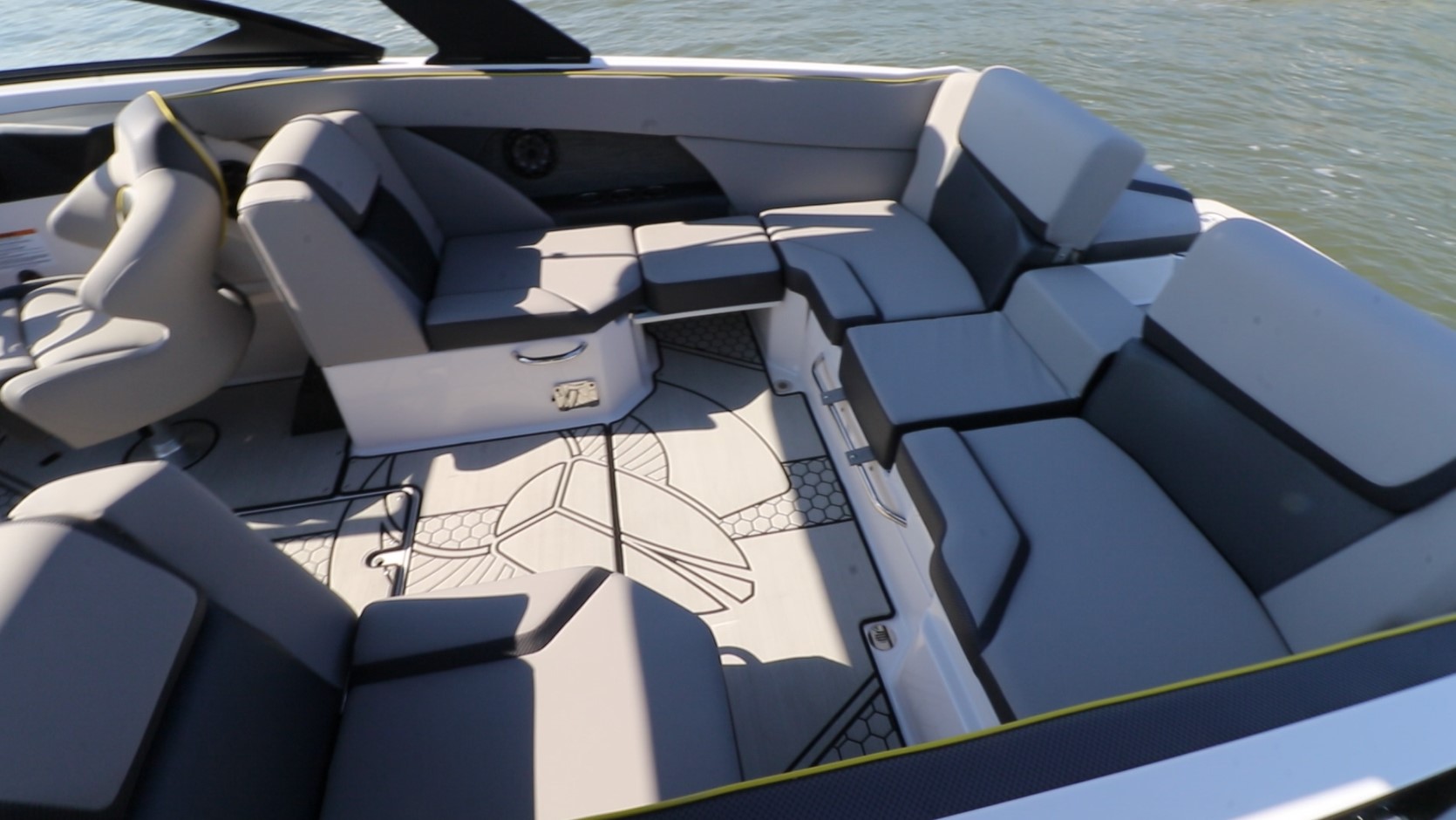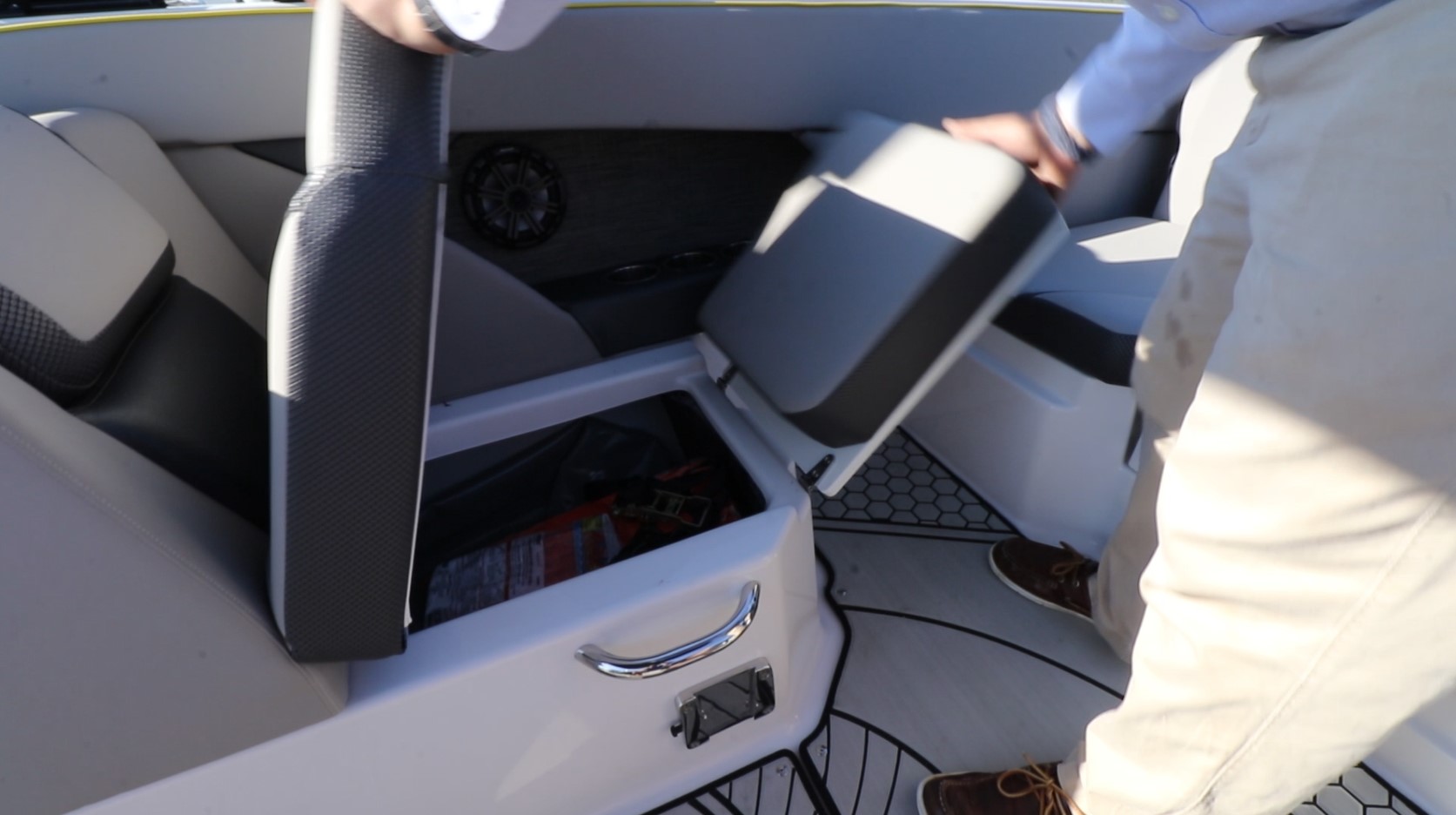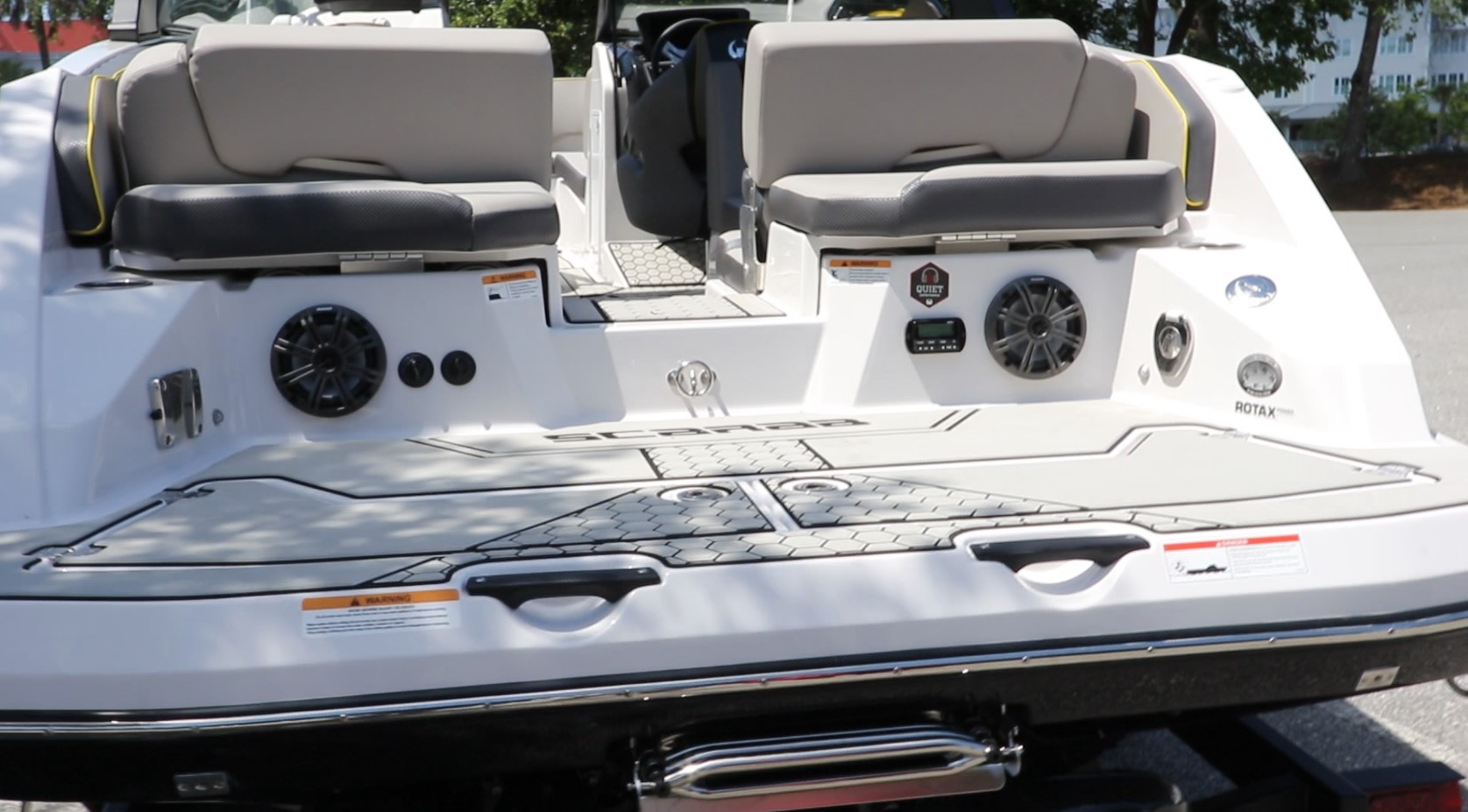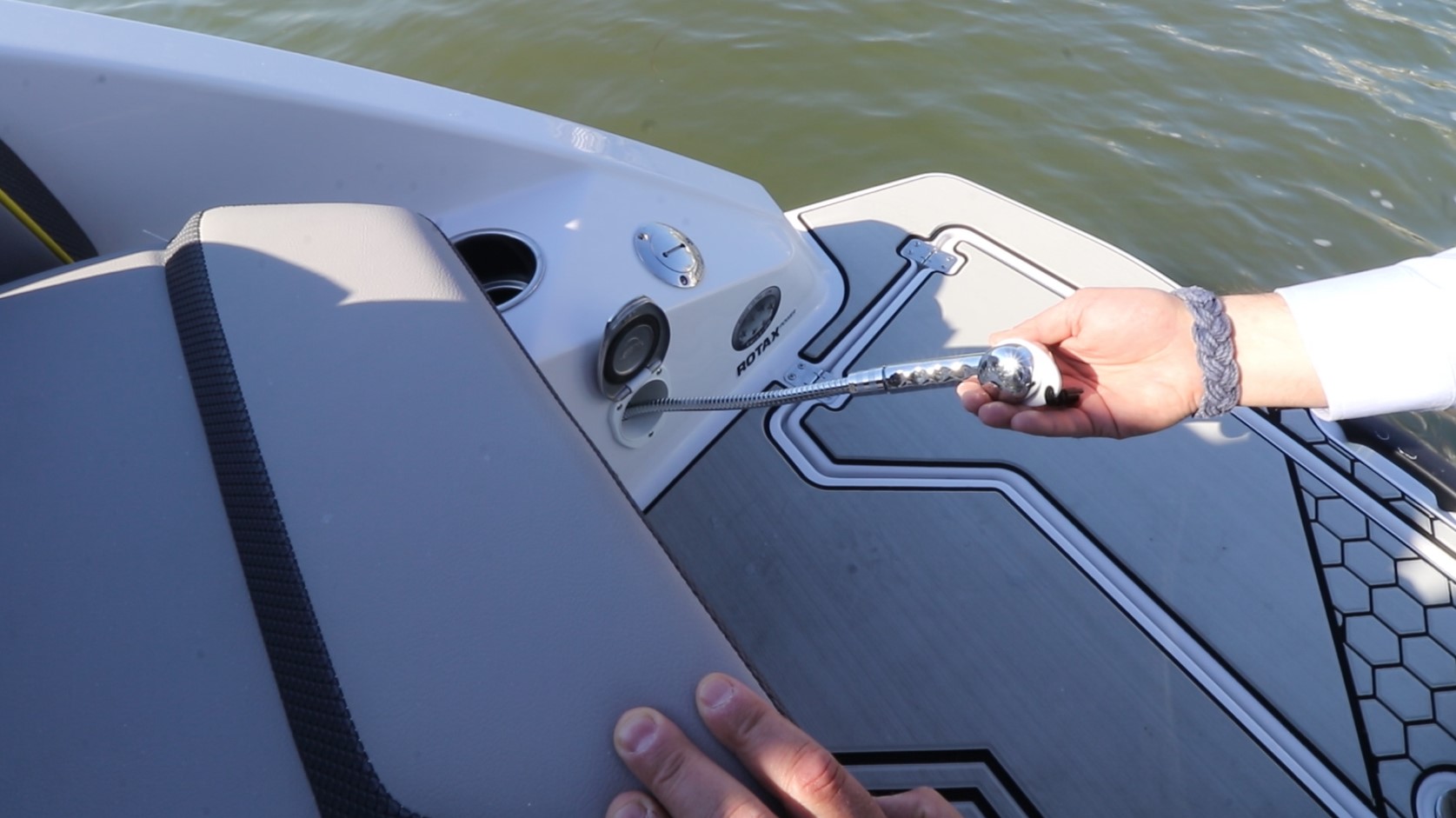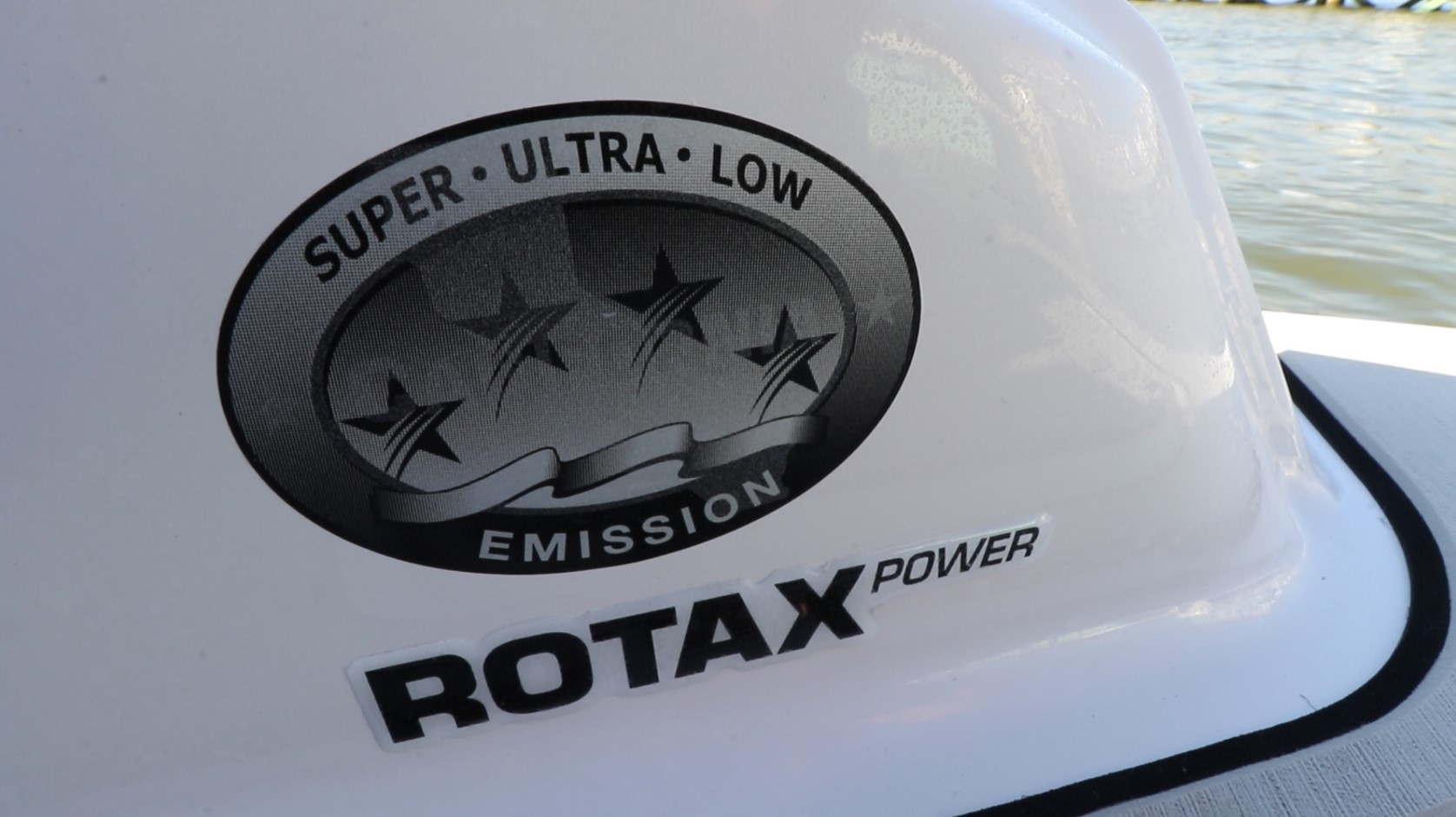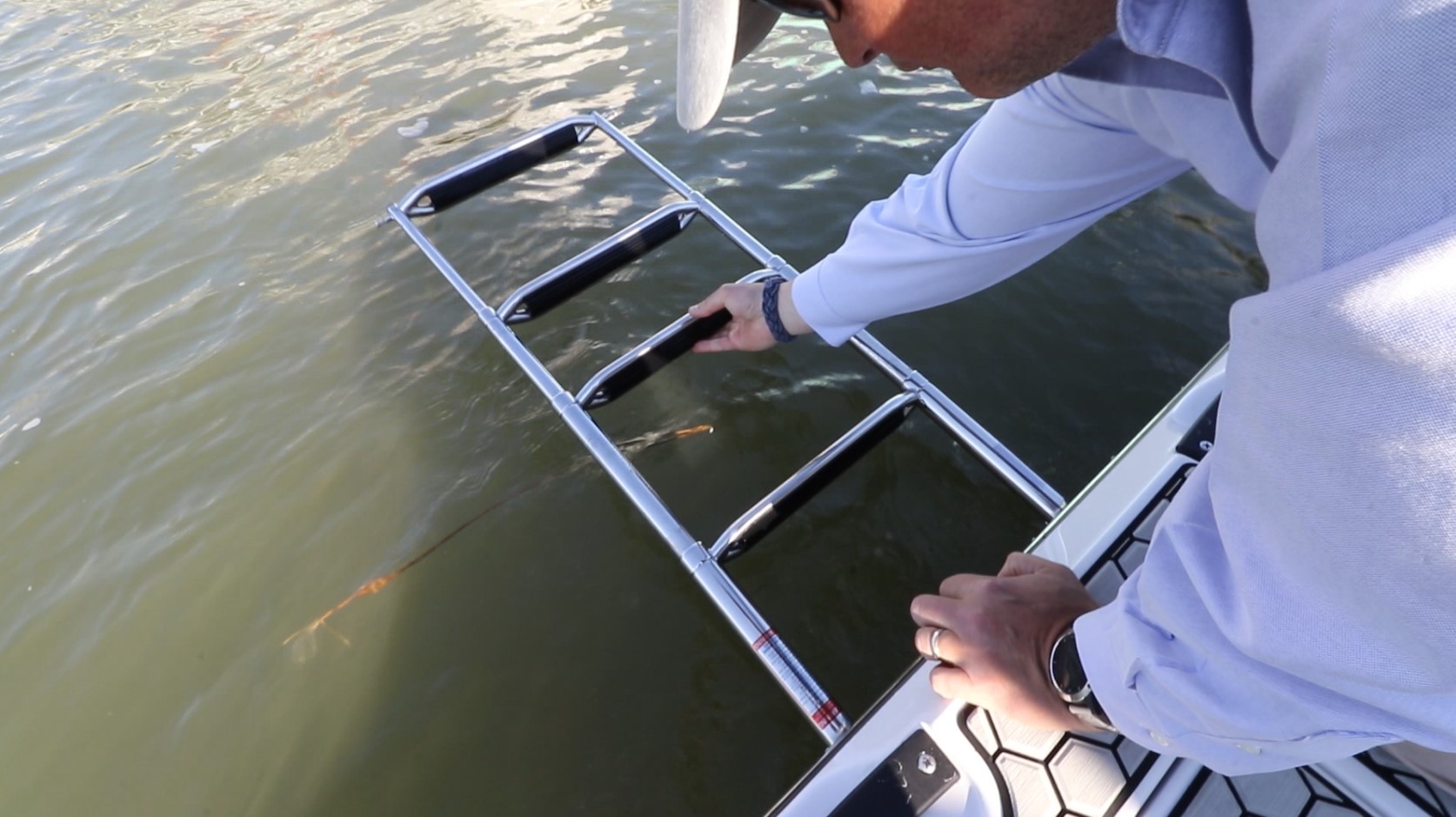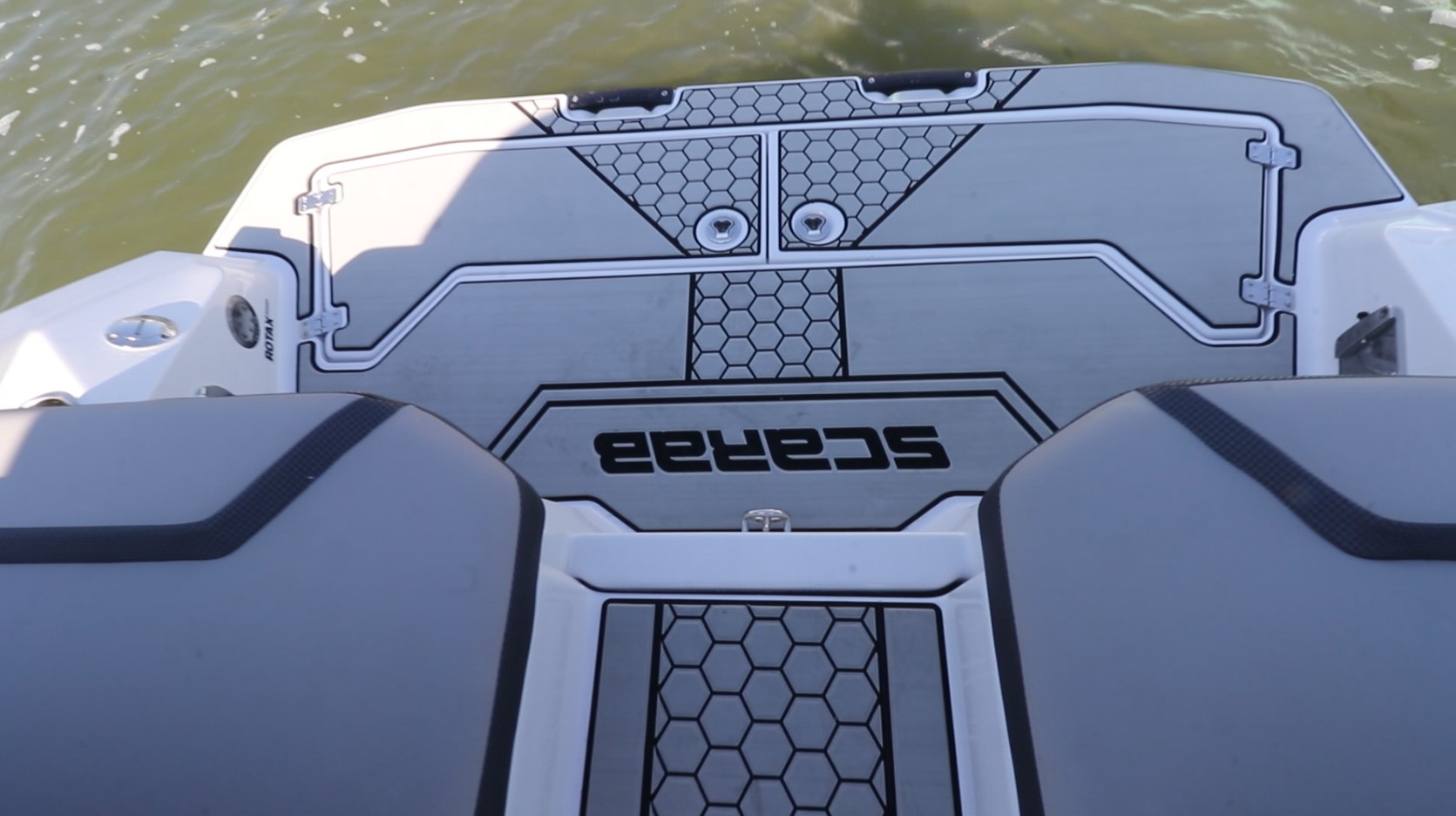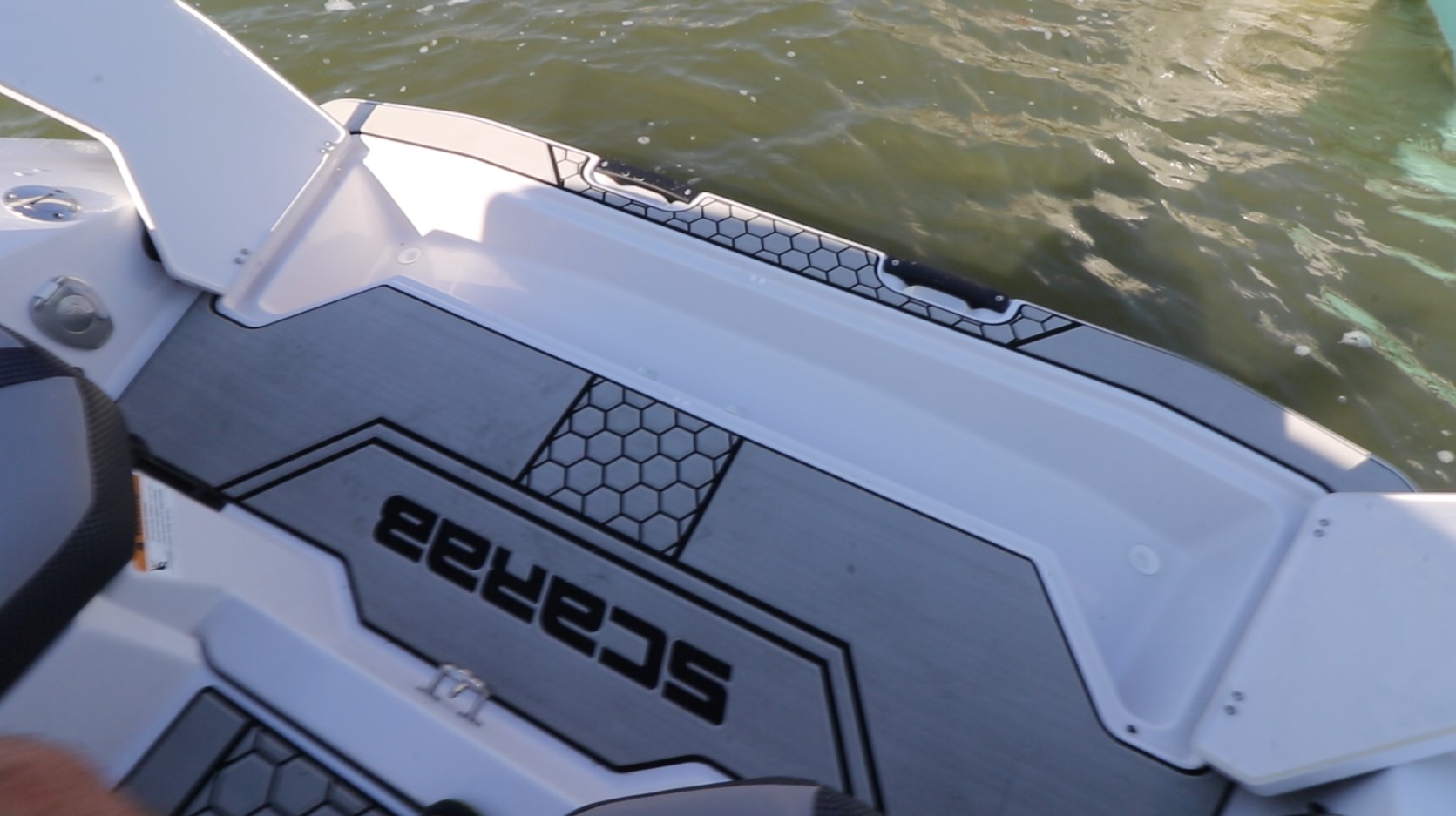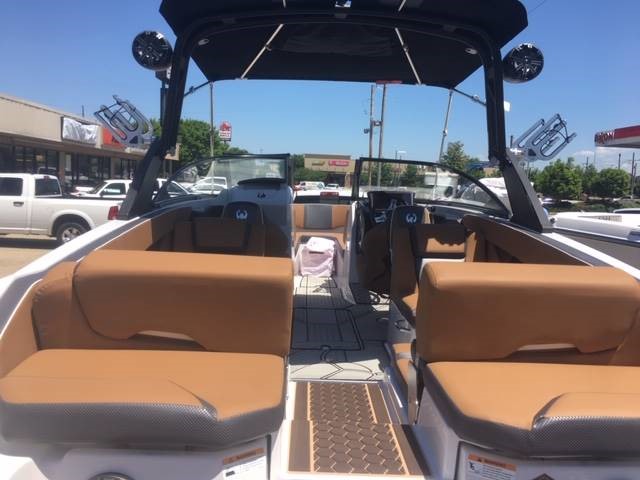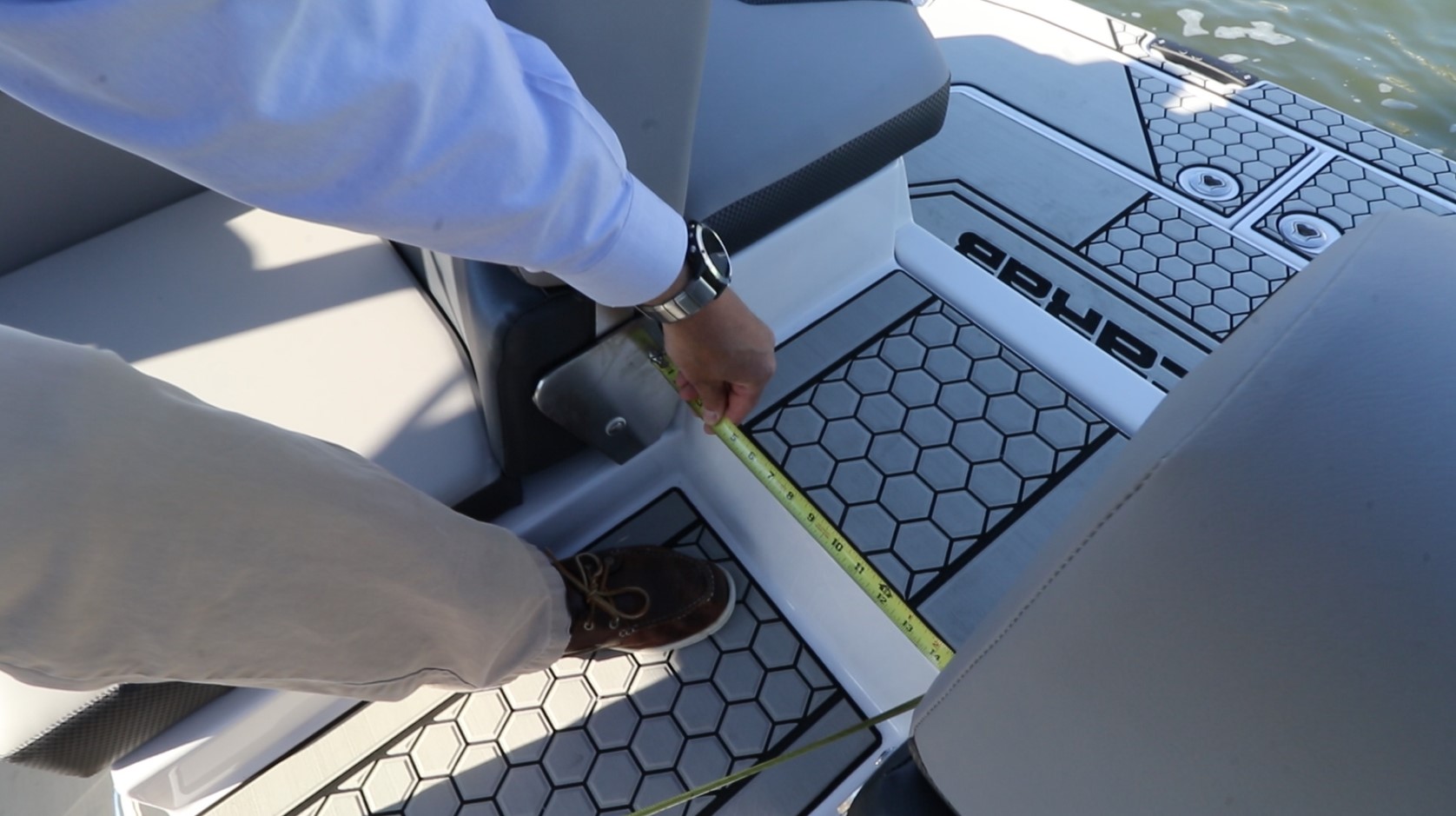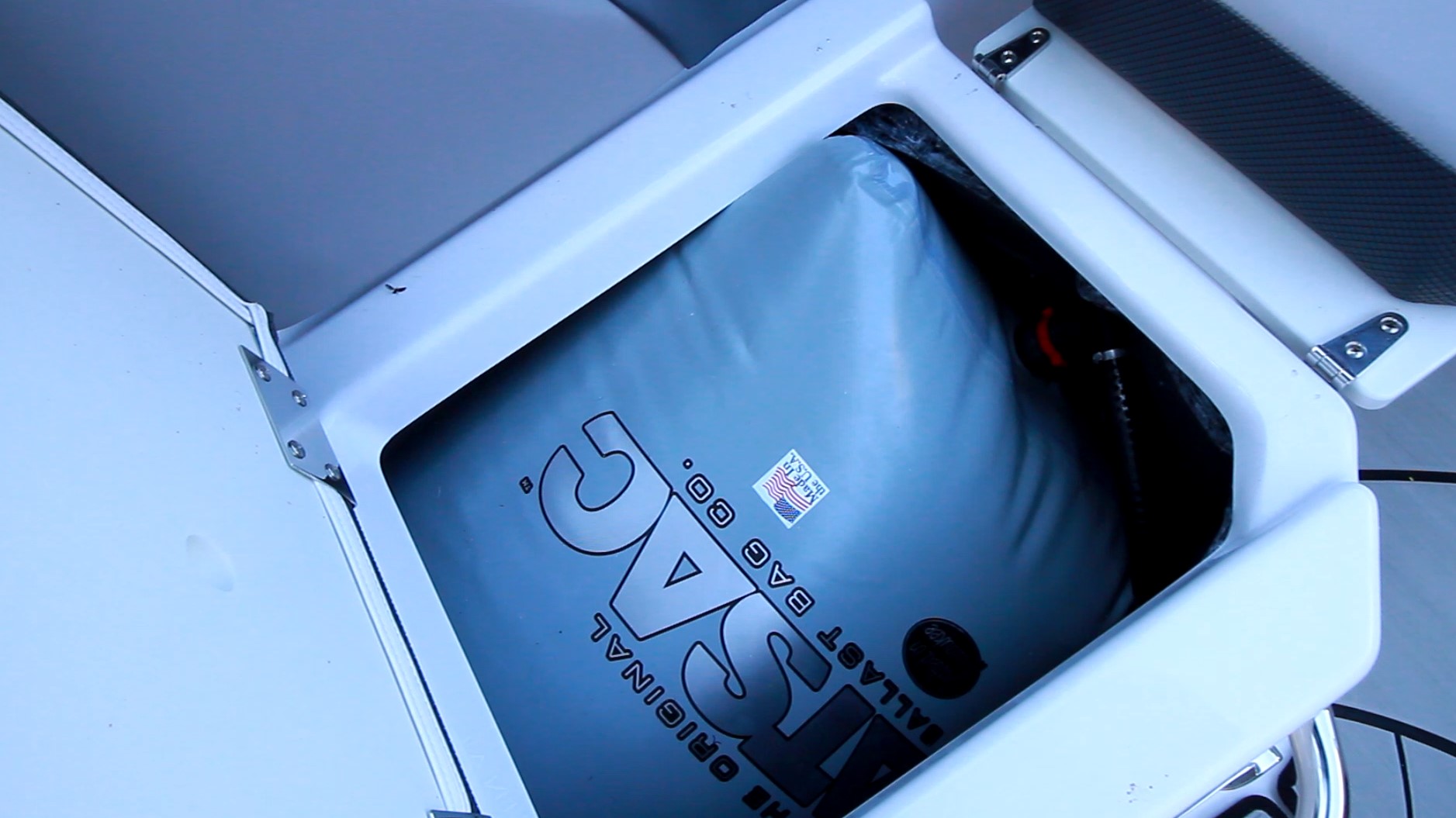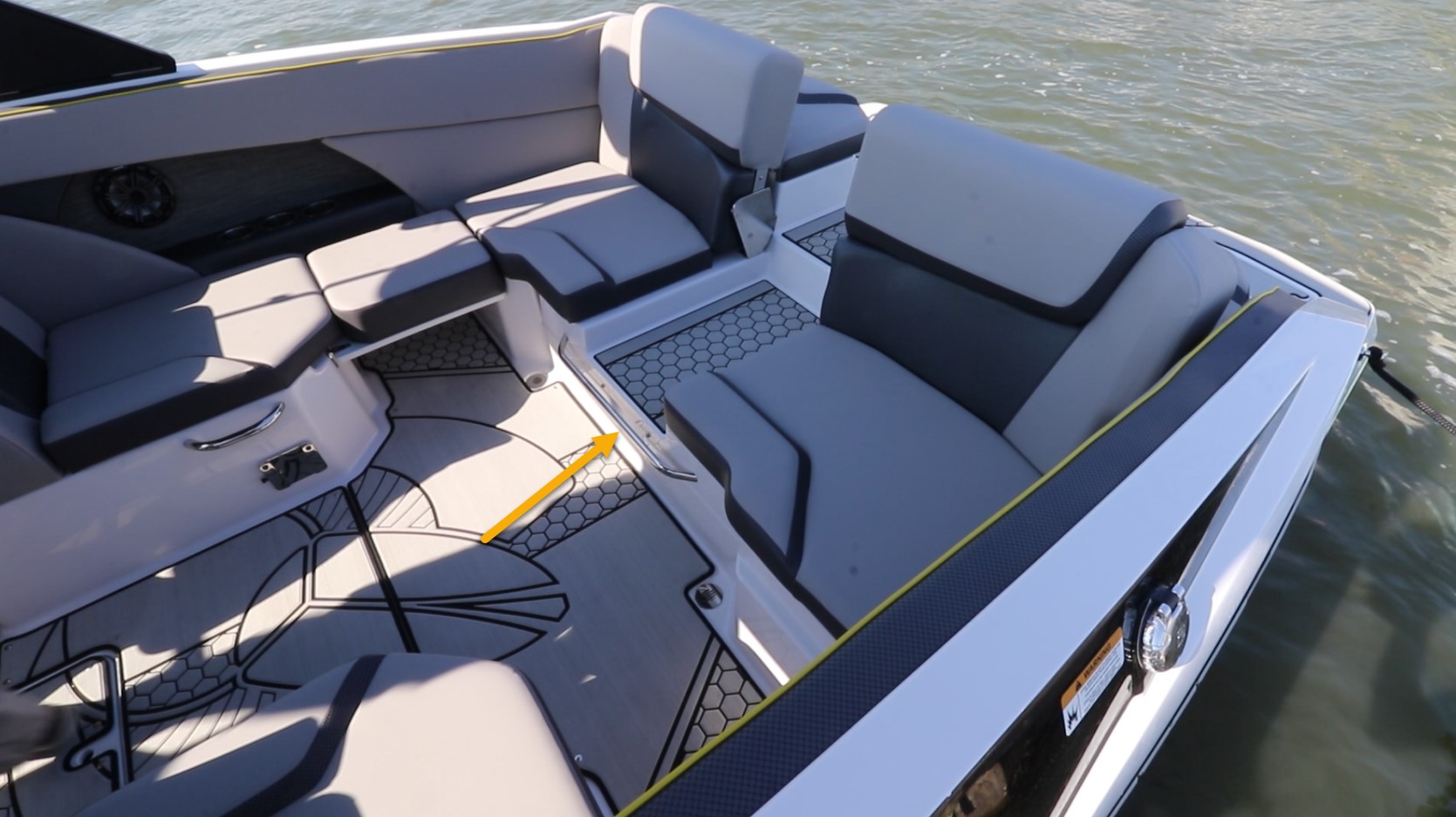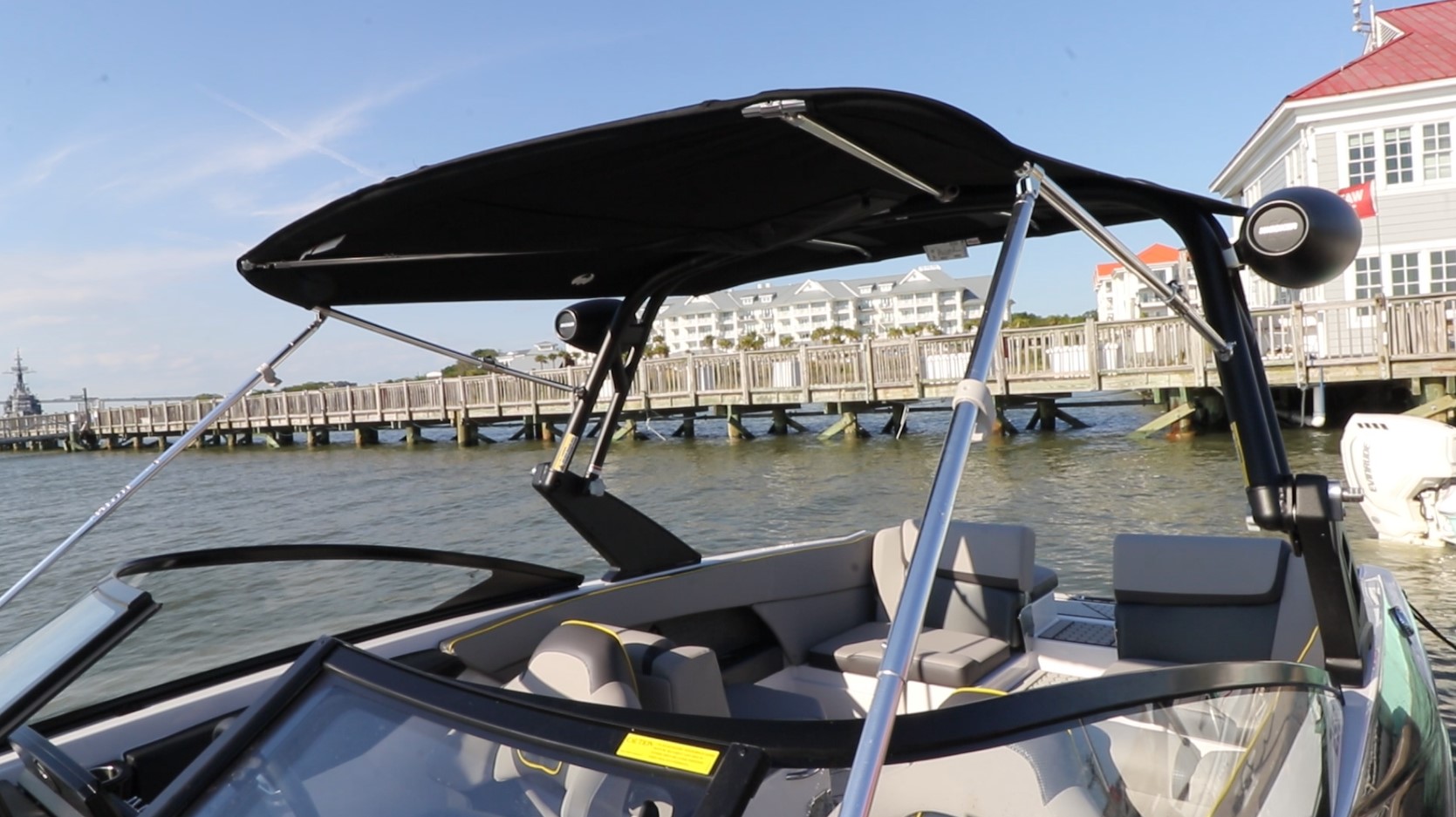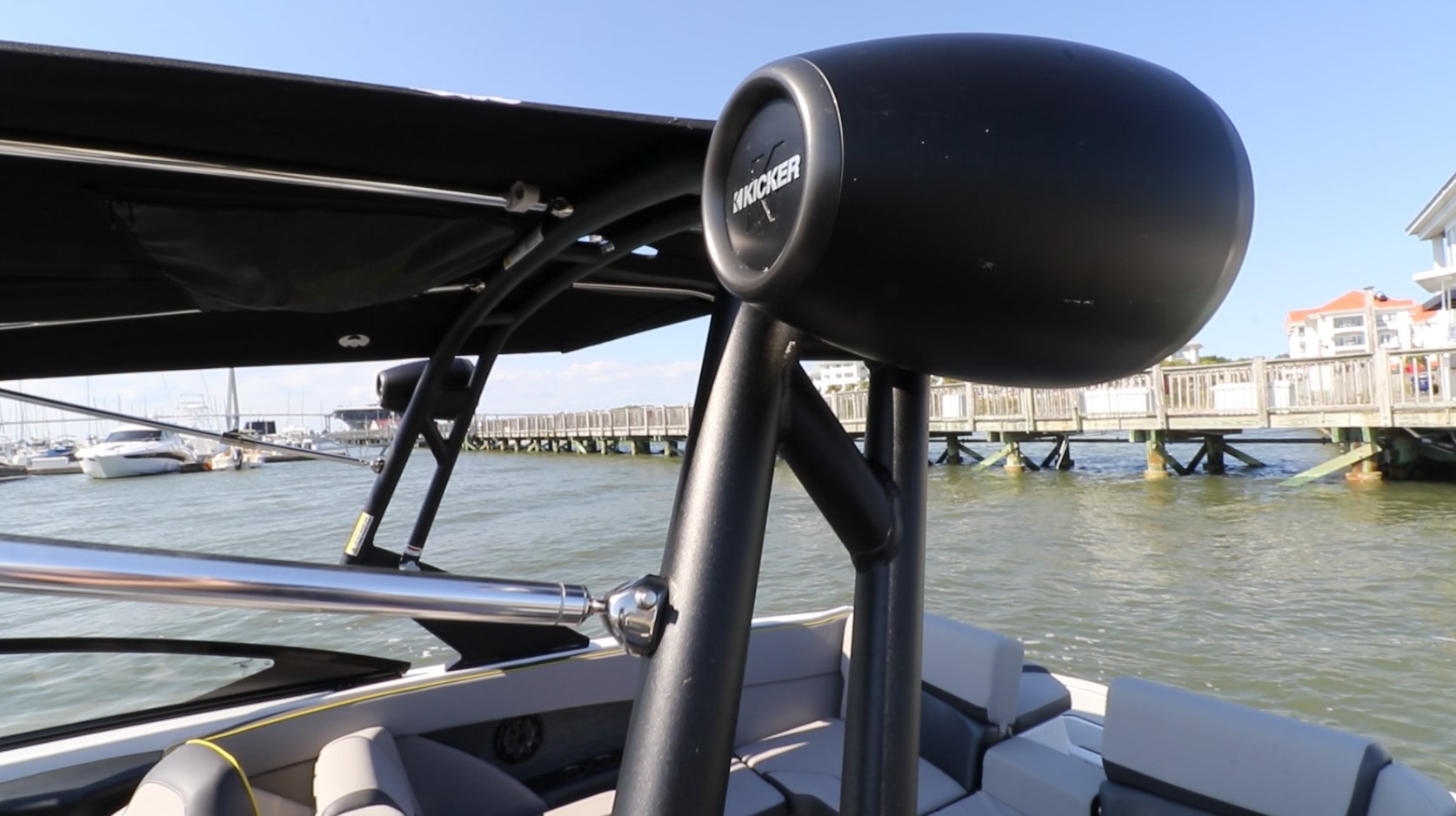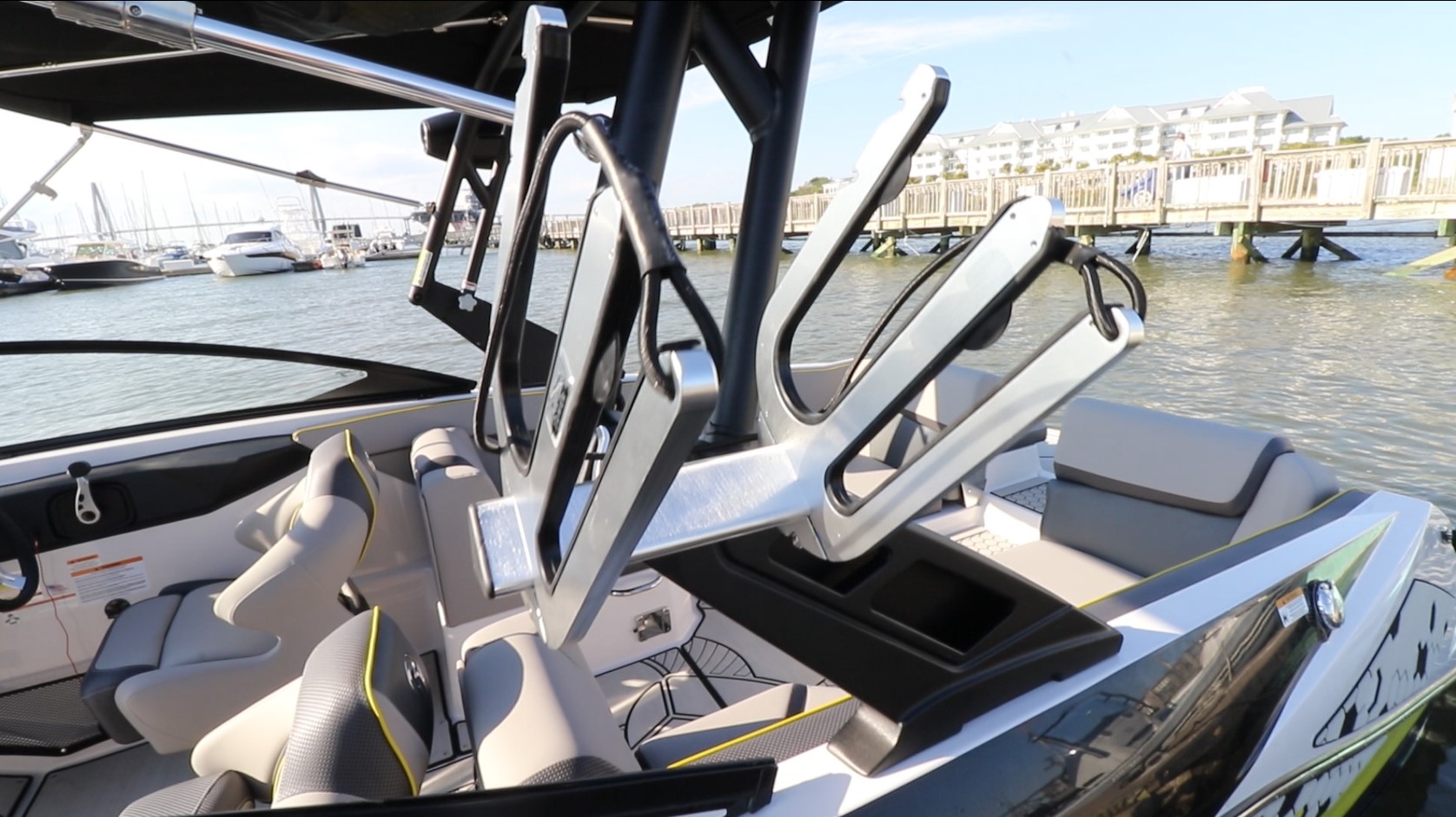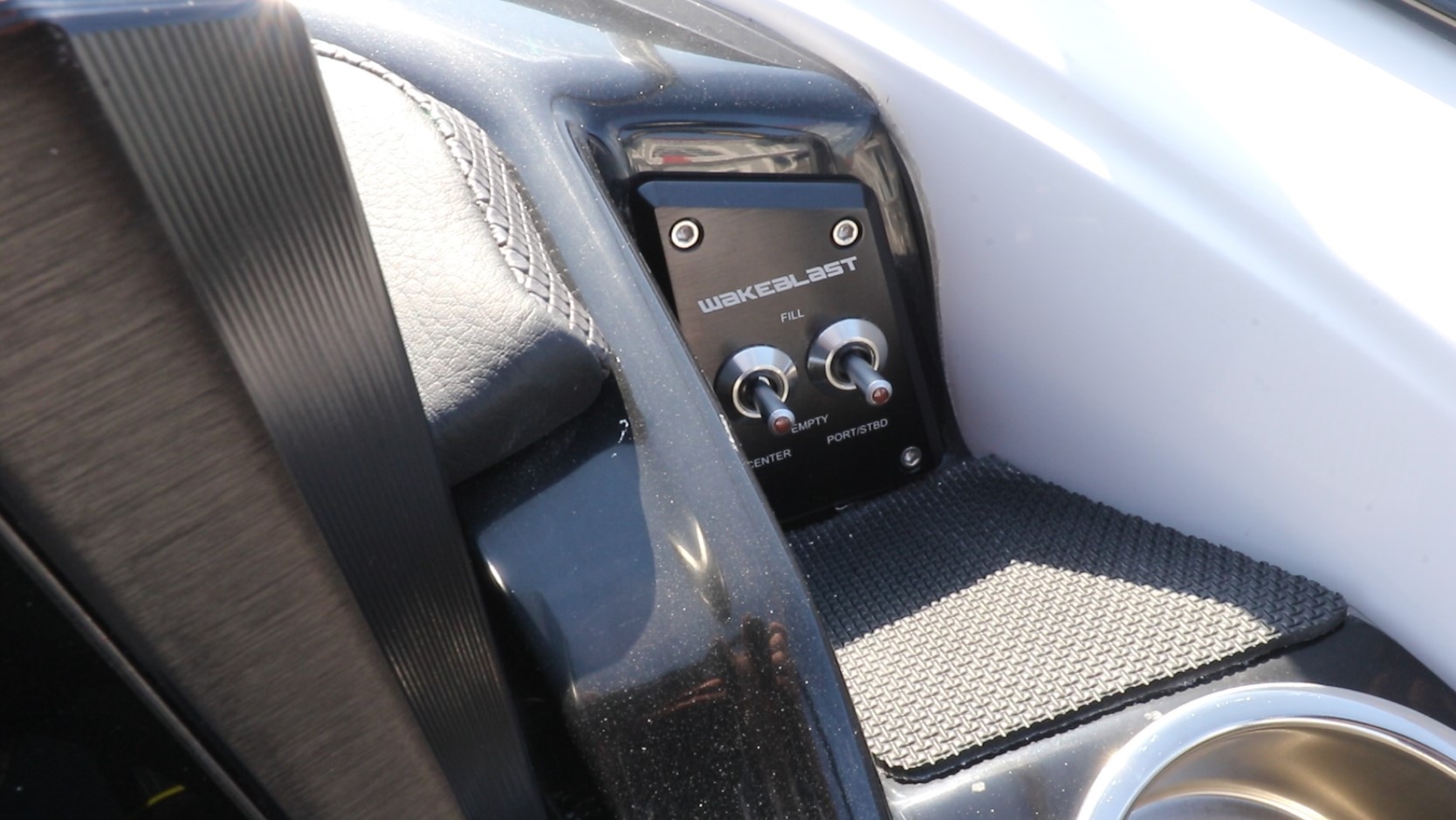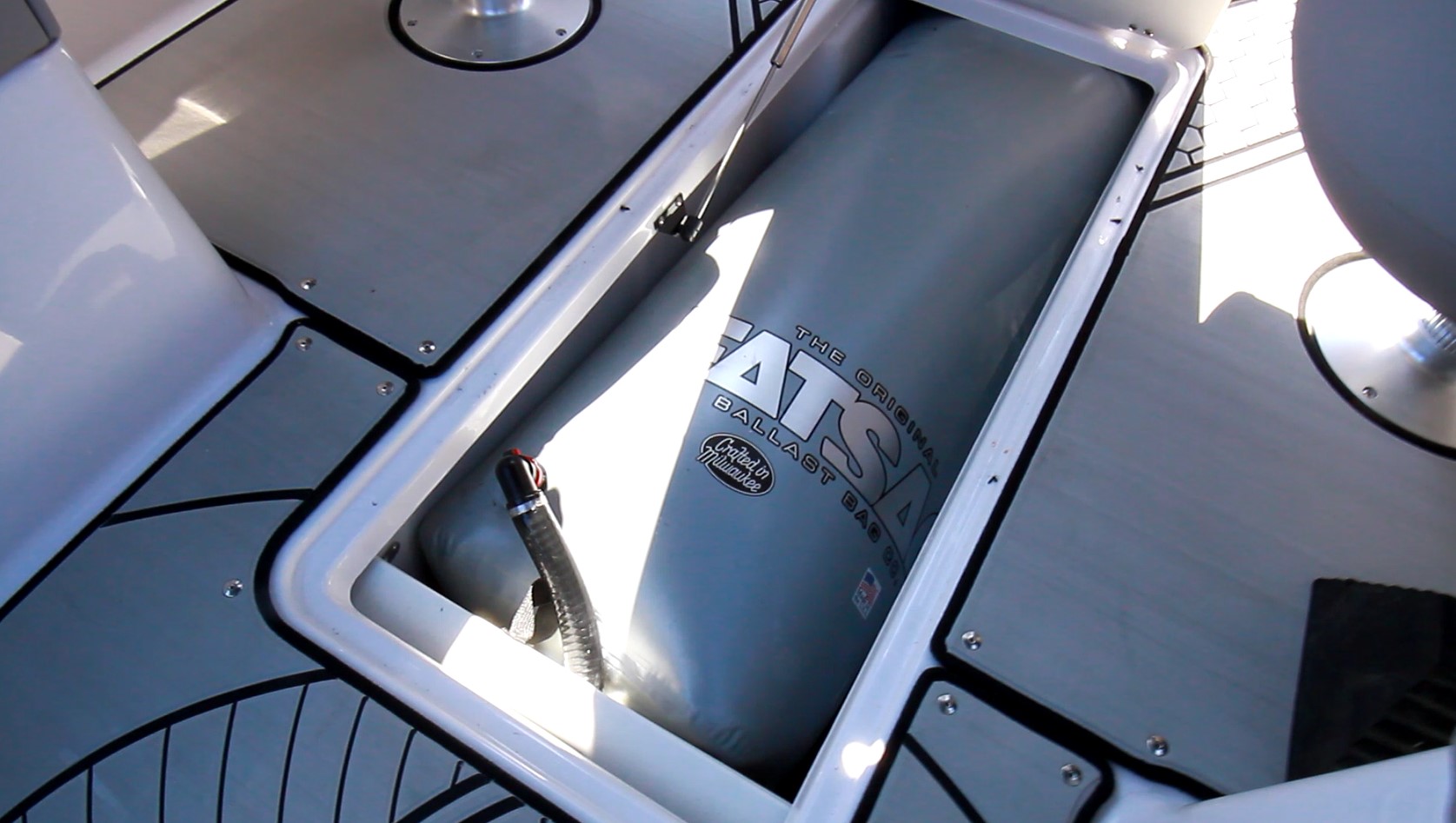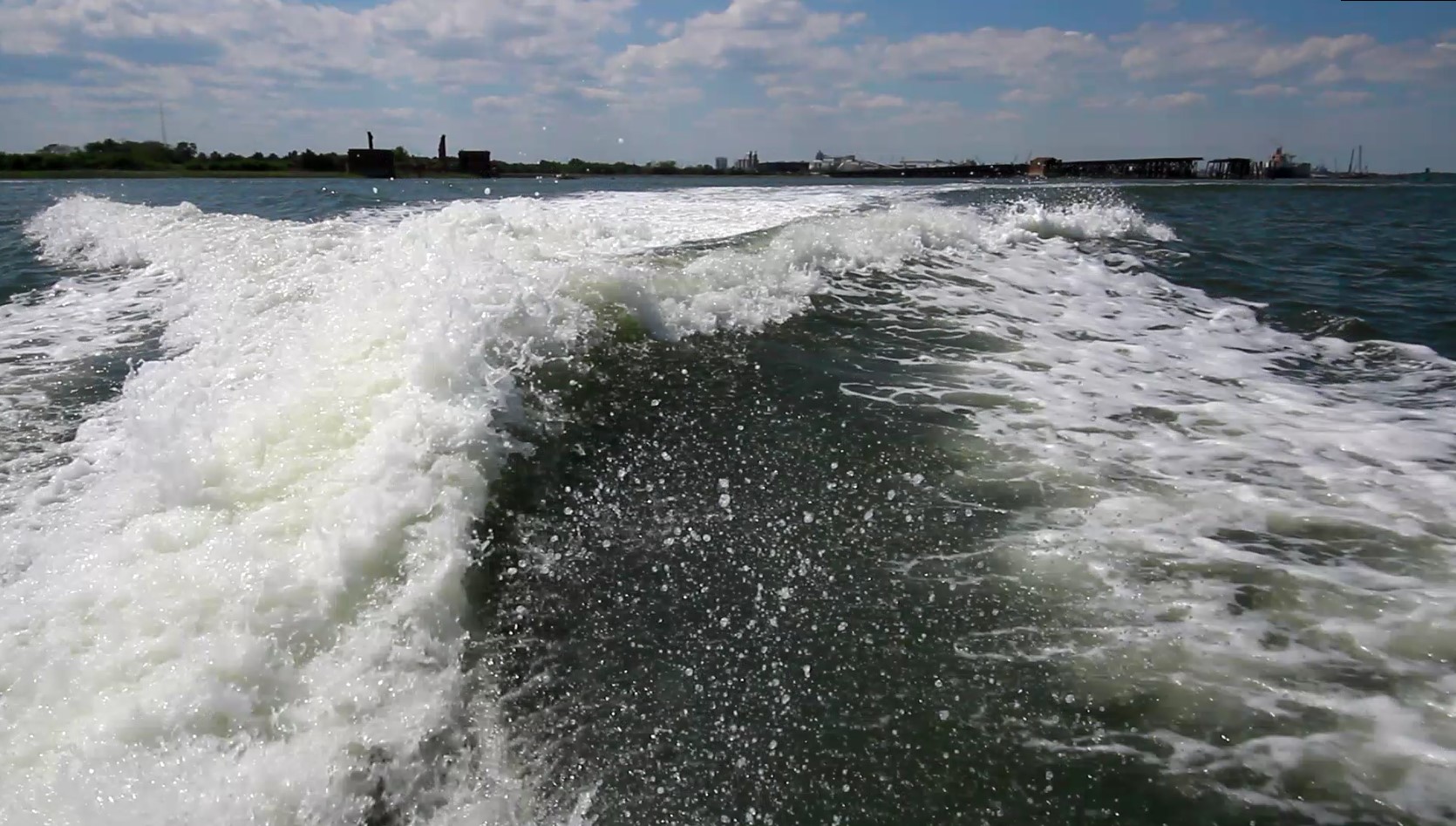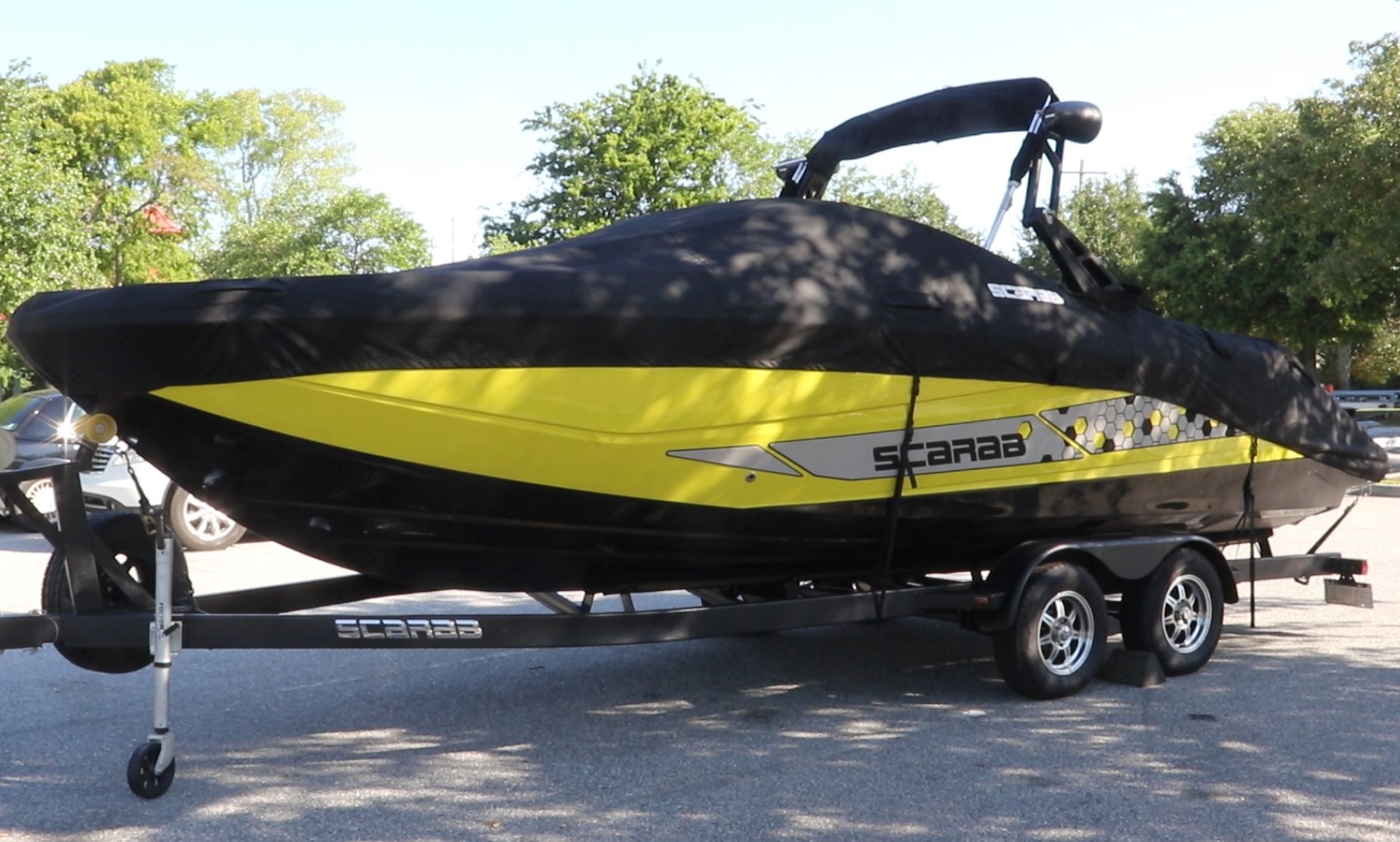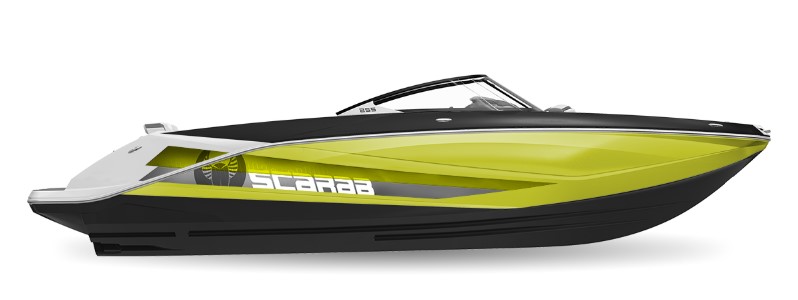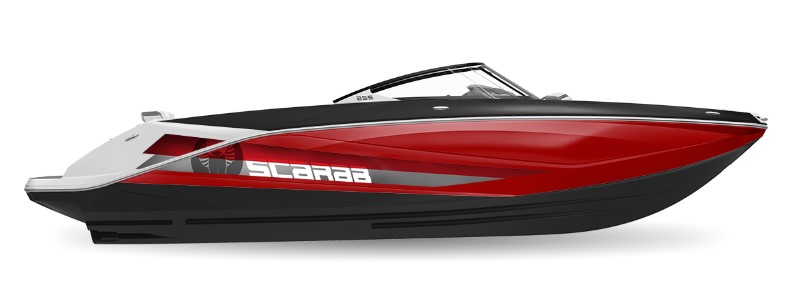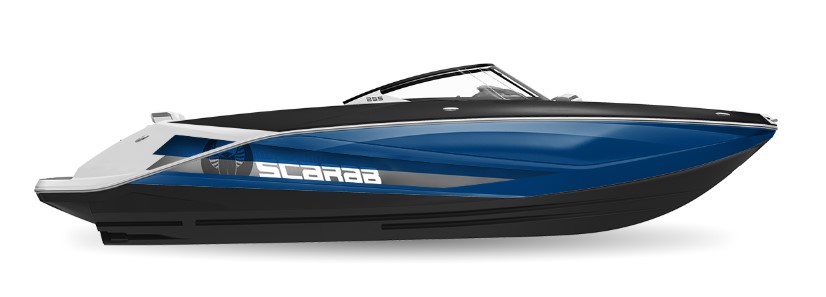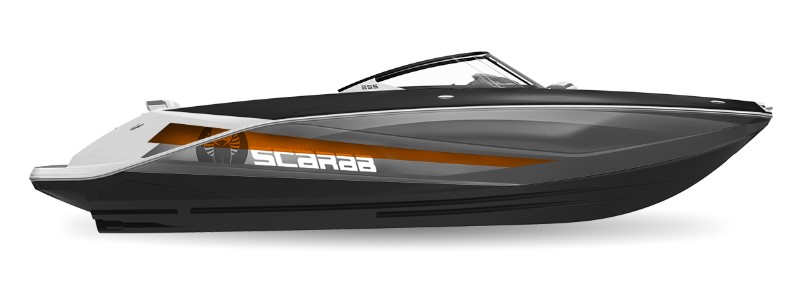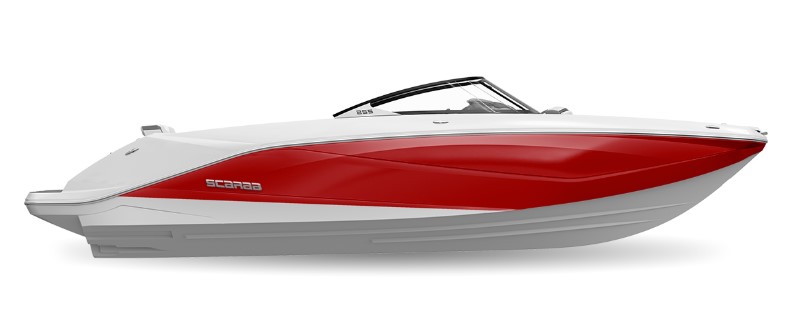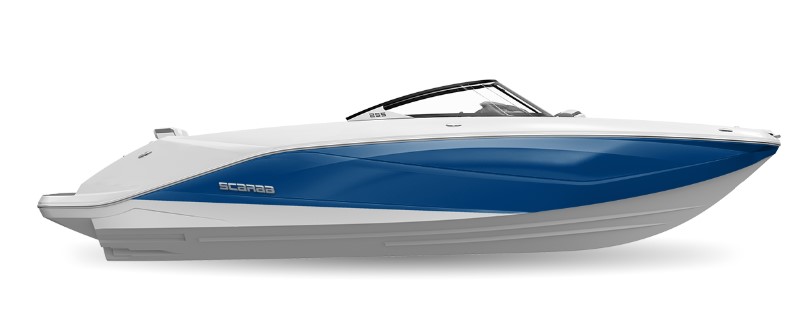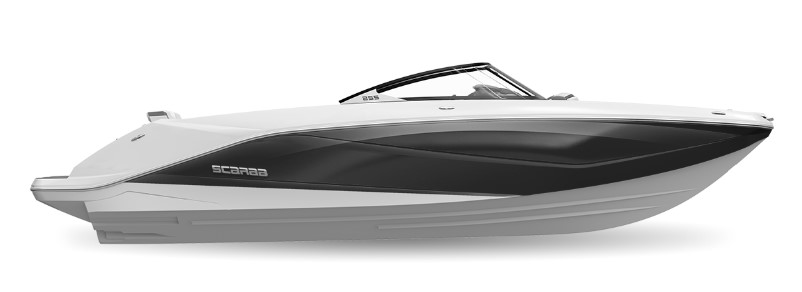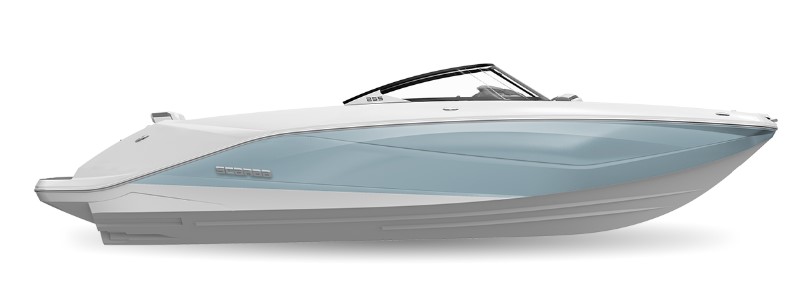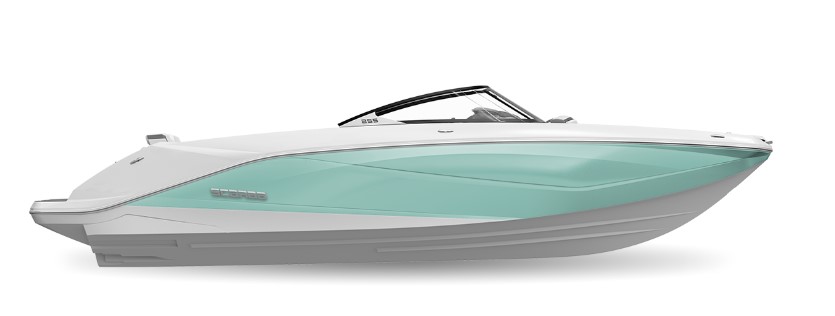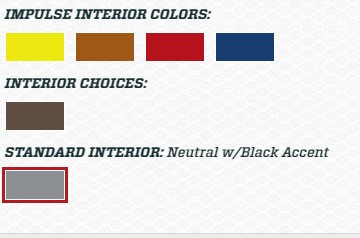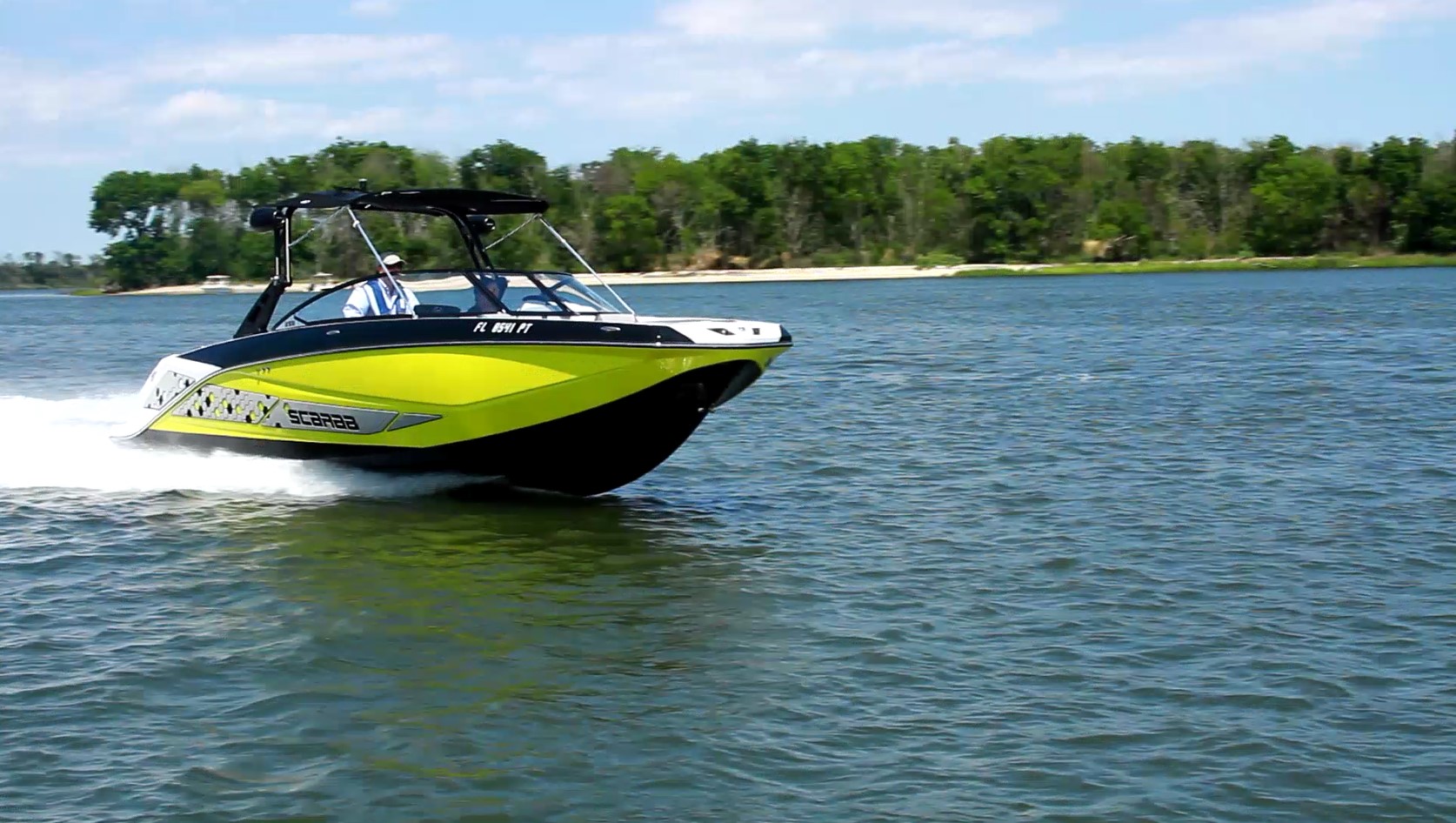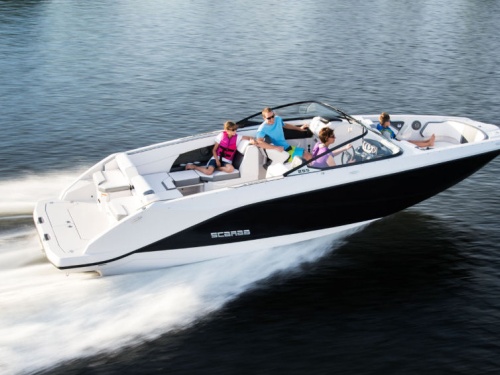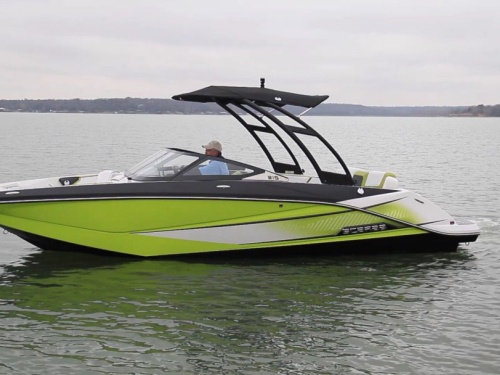Access More Boat Tests
Already have an account? Login
Scarab 255 ID (2019-)
w/ 2 x 250-hp Rotax 250 JPS
Price
See the price by becoming
a BoatTEST member.
Members Must Log In
Brief Summary
The Scarab 255 ID with twin 250-HP Rotax 4-TEC supercharged water-jet engines is a 25’ (7.62 m) long boat that can carry 13 people. Don’t confuse this boat with Scarab’s 255 Open ID, which is a center console. Our Scarab ID has a dual console, split-window layout with four distinct social areas: a swim platform conducive to in-water activities, an aft cockpit lounge, the dual console helm area, and up forward, a bowrider area that can convert to a sun pad.
The twin Rotax 4-TEC engines that power this ski and wakeboarding boat are not only powerful but they are the same reliable water jets found on Rotax’s parent company BRP’s Sea-Doo PWCs.
Key Features
- Dual console – split-window walkthrough bowrider
- Twin Rotax 250-hp water jet gas powered engines with speed control
- 13 person capacity
- Wake-producing water ballast bladders
- Enclosed change room/head
Test Results
| RPM | MPH | Knots | GPH | MPG | NMPG | STAT. MILE | NM | dBa |
|---|---|---|---|---|---|---|---|---|
| 1770 | 4.9 | 4.2 | 0.8 | 6.5 | 5.6 | 326 | 283.4 | 73 |
| 2000 | 5.3 | 4.6 | 0.8 | 6.6 | 5.7 | 331 | 287.6 | 75 |
| 3000 | 7.3 | 6.3 | 1.6 | 4.5 | 3.9 | 228 | 198.6 | 80 |
| 4000 | 10.5 | 9.1 | 2.4 | 4.4 | 3.8 | 221 | 191.7 | 85 |
| 5000 | 21.5 | 18.7 | 4.5 | 4.8 | 4.2 | 241 | 209.4 | 89 |
| 6000 | 33.5 | 29.1 | 7.3 | 4.6 | 4 | 233 | 202.5 | 94 |
| 7000 | 41 | 35.7 | 12.2 | 3.4 | 2.9 | 169 | 147.3 | 97 |
| 7950 | 54.5 | 47.4 | 18.4 | 3 | 2.6 | 149 | 129.8 | 100 |
| N/A | N/A | N/A | N/A | N/A | N/A | N/A | N/A | N/A |
| N/A | N/A | N/A | N/A | N/A | N/A | N/A | N/A | N/A |
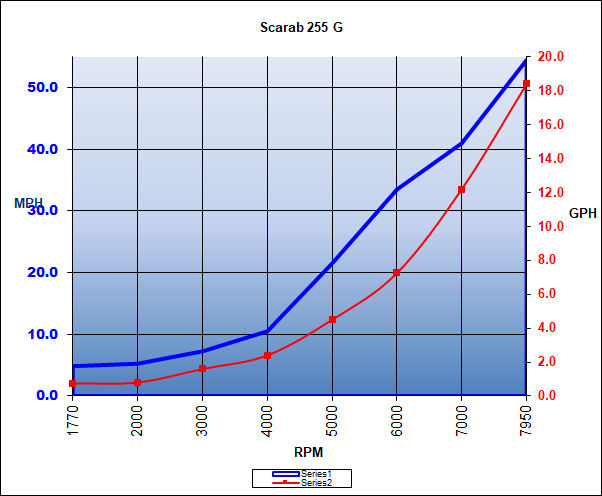
Specifications
| Length Overall | 25' (7.62 m) |
|---|---|
| Beam | 8' 4" (2.54 m) |
| Dry Weight | 3,660 lbs. (1,660 kg) |
| Tested Weight | 4,432 lbs. (2,010 kg) |
| Draft | 15" (38.1 cm) |
| Deadrise/Transom | 20-deg. |
| Max Headroom | open |
| Bridge Clearance | 7' 4" (2.24 m) |
| Weight Capacity | 2,100 lbs. (953 kg) |
| Person Capacity | 13 |
| Fuel Capacity | 56 gal. (212 L) |
| Water Capacity | 12 gal. (45 L) |
| Total Weight | 4,432 lbs. (2,010 kg) |
Acceleration Times & Conditions
| Time to Plane | 1.9 sec. |
|---|---|
| 0 to 30 | 4.2 sec. |
| Ratio | N/A |
| Props | N/A |
| Load | 2 persons, full fuel, 1/6 water, 50 lbs. of gear |
| Climate | 73 deg., 43 humid; wind: 7-14 mph; seas: 1-2 |
Engine Options
| Tested Engine |
2 x 250-hp Rotax 250 JPS |
|---|---|
| Std. Power |
2 x 150-hp Rotax |
| Opt. Power |
2 x 200-hp Rotax 2 x 250-hp Rotax 2 x 150-hp non-cat Rotax 2 x 300-hp Rotax |
Mission Statement
The 255 ID is the largest boat in the Scarab jet boat lineup. She is known for extreme wakeboard sports and lively parties, yet reserves herself for comfortable cruising. Her dynamic versatility and shaped surfs serve up an infinite stream of adrenaline rushes.
Distinguishing Rotax Engine Features
• Speed control - Intelligent Neutral and Reverse (iNR), fly-by-wire control
• Patented lateral thrust control
• iControl Modes - touch screen computer-aided controls
• Closed-loop cooling system
Major Features
• Twin Rotax 250-hp waterjet gas-powered engines with speed control
• 13 person capacity
• Wake-producing water ballast bladders
• Enclosed change room/head
Overview
Since the BRP subsidiary Rotax exited the boat building industry in 2012 to concentrate on just the engine side of the marine industry, builders from many companies have adopted the Rotax jet propulsion system, including Scarab, Chaparral, and Williams Jet tenders.
Scarab makes four 25’ (7.62 m) models: the 255 G dual console, the 255 ID dual console, the 255 Open G center console, and the 255 Open ID center console.
Pairing these twin jet 4-stroke Rotax engines on a sportboat makes sense from a safety standpoint alone – given that there are no props. And the boat has a draft of just 15” (38.1 cm) of water, making her ideal for skinny water without worrying about prop damage.
Performance
The twin Rotax 4-TEC engines that power this multi-use sportboat are the most powerful jets in class with their superchargers and intercoolers stepping up horsepower from 150 to 300-hp.
Our Scarab 255 ID test boat has a LOA of 25’ (7.62 m) and a beam of 8’4” (2.54 m). With an empty weight of 3,660 lbs. (1,660 kg), 2-gallons (8 L) of water in the 12-gallon (45 L) tank, plus 56 gallons (212 L) of fuel, and two people with test gear onboard, it had an estimated test weight 4,432 lbs. (2,010 kg).
Top Speed. With the twin Rotax 250-hp supercharged JPS gas engines powering our 255 ID test boat, it reached a top speed of 54.5 mph (87.7 kph) at 7950 rpm.
Best economic cruise came in at 5000 rpm and 21.5 mph (34.6 kph). It was at that speed that the 4.5 gph (17.0 lph) fuel burn translated into 4.8 mpg (2.03 kpl) and a range of 241 statute miles (388 km).
With the hammer down, the Scarab 255 ID got on plane in under 2 seconds. At 3.5 seconds the bow comes down and it hit 30 mph (48 kph) in 4.2 seconds.
Acceleration
Time to plane: 1.9 seconds
0 to 20 mph: 2.8 seconds
0 to 30 mph: 4.2 seconds
Power Options
Five different engine configurations are available.
• Twin Rotax 4-Tec ECT 1.5 L Supercharged HOINR ($79,900)
• Twin Rotax 300 PT/ST 1.6L *Limited Availability ($82,567)
• Twin Rotax 4-Tec 150 ECT 1.5 L Injected iNR ($68,733)
• Twin Rotax 4-Tec 150 Non-Cat 1.5 L Injected iNR (not available in CA and CE) ($68,733)
• Twin Rotax 4-Tec 200 ECT 1.5 L Supercharged iNR ($74,433)
Engine Features
Closed-loop engine cooling protects the engine from harmful salt, gunk, and corrosion by cooling it with clean coolant like a car. Every Scarab has a thermostat to ensure optimal engine temperature for reliability. A driveshaft sleeve helps prevent the problem of wrapping debris, such as tow rope weeds, around drive shafts. Unlike other boats, which feature a small, plastic reverse gate, Scarab’s aluminum reverse gate offers unmatched low-speed maneuverability to make docking easy.
Engine Warranty. Rotax engines feature a standard warranty of 3 years/480 hours.
Handling
The supercharged 3-cylinder, 4-stroke engines on this boat provide excellent acceleration as evidenced by the time to plane numbers and a top end speed. Time to plane is important for skiers and wakeboarders, making it easier for them to get up on top of the water.
Because this boat is sucking in water, the faster it goes the more suction it has, and the better it sticks to the water, giving the boat the ability to grab the surface and carve into turns at WOT.
The Rotax propulsion system is demonstrably different from the competition in several ways.
• First, the jet nozzles are not stationary, they move from side to side. That provides much more maneuverability at all speeds.
• Second, because of the shape of the bucket when it is down, it can direct thrust forward or from side to side.
• Third, Rotax has intelligent neutral and reverse for which it won an NMMA innovation award. From the helm, the operator can adjust the bucket slightly up or down because the system is all digital, not cable, and make minute adjustments to keep the boat in absolute neutral. In this way, there is no creep, as there is with other brands.
This combination of propulsion attributes provides positive low-speed handling control around a dock or when maneuvering to pick up boarders in the water.
Boat Inspection
The builder has told us that what makes the 255 ID popular is her interior, seating capacity, versatility, and speed.
This jet boat is 25’ (7.62 m) long and can carry 13 people, or a total of 2,100 lbs. (953 kg) of people and gear, whichever is less – in the U.S. However, in Europe and countries following CE standards, the capacity rating is for 11 people.
Anchor
All the way forward, the hatch to the anchor locker opens to the side with a preventer strap to keep it upright. A bow ladder and Danforth-style anchor are inside – we’d like to see anchor keepers on the bracket to hold the anchor in place.
Bow
The bow has a squared flare on the topside, providing more space for loungers to either side and a wrap-around bench and bolster forward.
The bulwarks forward are high enough that the wrap-around bolster is also a seatback. Speakers, cupholders, and grab handles accent the space.
The builder has told us that what makes the 255 ID popular is her interior, seating capacity, versatility, and speed.
The Helm
The wrap-around windshield is tempered-glass. Each console has a flat dash pad and supports for the windshield. The center windshield panel has a 22” (55.88 cm) wide opening between the consoles.
The helm has a three-spoke tilt wheel, and the 12” (30.38-cm) touchscreen frames the top of the helm dash. This digital combo gauge has water temperature, speed, fuel, charge level, tach and all of the usual engine and boat diagnostics, including GPS and chartplotter.
Its mode setting offers four computer-controlled modes to match activity:
• Cruise mode is like setting cruise control in a car, keeping a constant speed.
• In dock mode, the throttle has 20-percent of thrust of WOT (Wide Open Throttle) in the same throw distance of the throttle, giving better feel and maneuverability.
• In eco mode, the boat automatically finds the best fuel efficiency for the maximum on plane range.
• In ski mode, 5-speed preference settings can be set to individual skiers so that exact speeds can be repeated regardless of driver ability. These speeds can be tweaked incrementally to get the setting just right.
To the left of wheel is a horn button. Toggle switches with indicator lights are to the right of the wheel, with key and ignition buttons for each engine just below. The safety lanyard and kill switch are on the bulwark in front of throttle. To the far right of the console is a wake blast ballast system used for filling the ballast tanks for wakeboarding. There is a cup holder behind, which will be a good place for a cell phone.
The throttle is on the side bulwark, and is noteworthy because one digital throttle and shift control activates both engines.
The single throttle simplifies control, taking the confusion of twin levers out of the picture. Beginning boaters will like this feature. Below the throttle and shift is a storage net.
Helm Seat. The Scarab has a contoured helm seat which sits on a pedestal base with built-in headrest. It slides fore and aft, swivels, and has a flip-up bolster. There is an open back for ventilation, and a padded armrest on the bulwark behind the throttle.
The helm console has a side access door with a 36-quart (34 L) cooler on a slide and dedicated storage for the table and bracket behind the cooler.
Inside the helm console is dedicated storage for the table support. It is easier to remove the cooler from the slide when placing or retrieving the support.
The companion seat has the same adjustments and bolster as the helm chair along with a footrest, audio input jack, USB and 12V charging ports and speaker toggle switch on the bulwark, along with a cargo net. The bulwark is padded next to the seat and there’s a grab handle just in front. A padded armrest runs along the gunwale, ending in a cupholder by the passenger console. The console opens into the optional head compartment. An enclosed changing room is standard.
The head compartment has a light over a vanity sink, and our test boat had a Dometic toilet. The compartment has 3’10’’ (1.17 m) clearance from deck to overhead. There is seated clearance of 29” (73.66 cm).
Looking between the seats, we can see the Scarab logo on the seatbacks and the in-deck storage.
The rear-facing seat on the starboard side has a table mount attached to its base. There is optional Marine Mat decking in the cockpit. Also, note the grab handles on each seat base as required by ABYC standards. This boat is NMMA certified.
Let’s remove the center filler cushion in the cockpit bench seat and check out the engine space below.
Engines
There are separate battery compartments to either side. The right contains batteries and the battery switch, the left side has batteries and the 12-gallon (45 L) water tank. All the batteries have proper tie-down straps.
The 4-stroke, 3-cylinder in-line engines were designed for the marine environment, so all the regular maintenance points are on top.
A main reason why the Rotax engines have a 1-year anti-corrosion warranty, and a 3-year overall limited warranty is the closed loop cooling system which eliminates salt and sediment. The closed loop cooling system is essential for shallow water operation.
Aft Cockpit
The aft cockpit has two forward-facing seats that have a filler cushion that can form a bench across the back. The handle below the filler cushion is for opening the engine compartment. Deck drains are just below the handle.
Aft facing bucket seats, one on each side of the boat, have molded bases with seats that open and have fold-out leg supports to make 61” (154.94 m) long chaise loungers. Here is where the spotters sit, and in fact the whole cockpit can be configured to maximize seating for spectators watching the show behind the boat.
Swim Platform
When entering the boat via the platform, the first thing you notice is the decking. The gray swim platform mat is an option, but makes moving around in bare feet comfortable with good traction.
Features on the swim platform include the tow ring, stereo controls, speakers, waterfill, and a pull-out shower head.
There is a large in-deck storage compartment extending across the aft section of the swim platform that can stow tow lines, mooring lines, small fenders, wet bathing suits, and other gear. There are port and starboard overboard drains.
Two rear-facing seats are positioned for launching watersports, and when anchored, watching kids swimming behind the boat. They are not to be used as spotters’ seats. These share seatbacks with the aft cockpit bench seats, so simply flip the seatback into the desired position. A cup holder flanks each seat.
Wake Edition Package
As we put the leg back under the seat, note the additional storage in the seat base. These hold the wing tank FATSAC ballast bladders for the wakeboarding system.
It is important to remember that this is a 25’ (7.6 m) boat and note how large the cockpit is. The reason for this is the jet engines and drives have a low profile and seats can be put on top of them. Sterndrive engines are high and seats must be put forward of them, reducing cockpit space.
Wakeboard Arch
Scarab integrated the arch with the Bimini. The arch has an overhead clearance of 79” (200.66 m), and has speakers and places to carry wakeboards and skis.
Wake System
Trailer
Scarab’s custom trailer features:
• Tandem axle
• Brakes with chrome wheels
• Swing away tongue
Other Optional Equipment to Consider
• Cockpit marine mat ($1,000)
• Swim platform mat gray ($433)
• Trailering cover ($973)
• Wakeboard tower ($3,432)
• Wakeboard tower Bimini top (canvas only) ($1207.75)
• Wakeboard racks ($627)
• Bow and cockpit cover ($693)
• Digital speed control package ($880)
• Head Porta-Potti ($247)
• Impact graphics ($513)
• Galvanized trailer ($913)
Tow Sports Options
The 255 ID comes with surf/wakeboard racks and wakeboard tower speakers (requires premium sound package and tower/arch). Three optional packages are available.
• Surf Stream Wake Enhancement System ($860)
• Wake Ballast System ($2373)
• Wakeboard tower, hinging with gas-assist and Bimini top ($3,700)
Color Options
A variety of colors are available.
Exterior
J
Interior Colors
Price
Starting at $62,866 (U.S. and Canada only).
Observations
Overall, the Scarab 255 ID provides a platform for friends and family to enjoy boarding, skiing, and other water activities without worry about propeller accidents. The new generation of control systems of the jets is more user-friendly and easier than ever before. And with reliable, powerful, and highly maneuverable jet drives. The jet nozzles on the Rotax swivel from side to side, which gives this system some advantages over others.
A customized Scarab 255 ID built-to-order takes six to eight weeks from the factory. We recommend the digital speed control package. The other options, depending on one’s use of the boat are obvious.

